The latest travel advice and guide to visiting the Spanish Canary Islands in 2025.
The best islands in Europe to visit at anytime of year if you are looking for warmth and sunshine, the Spanish Canary Isles are a perfect destination for an exotic holiday. Infinite golden sand beaches, shimmery black sandy coves, the greenest of nature trails, and a colourful marine life, you’ll be fascinated by the contrasting landscapes of the eight volcanic islands surging from the Atlantic Ocean.
Discover where to go and what to do, in our Canary Islands travel guide to Tenerife, Gran Canaria, Lanzarote, Fuerteventura, La Gomera, El Hierro, La Graciosa and La Palma.
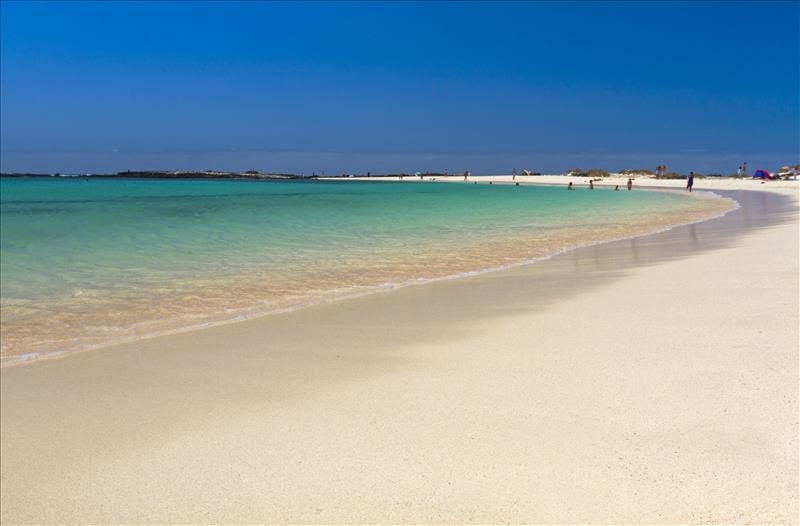
El Cotillo Beach, Fuerteventura Island.
- Travel Guide To The Spanish Canary Islands
- 1. TENERIFE Travel Guide
- 2. LA GOMERA Travel Guide
- 3. LA PALMA Travel Guide
- 4. EL HIERRO Travel Guide
- 5. GRAN CANARIA Travel Guide
- 6. LANZAROTE Travel Guide
- 7. LA GRACIOSA Island
- 8. FUERTEVENTURA Travel Guide
- Canary Islands Information Guide
- Useful advice for travelling to the Canary Islands
- Weather in the Canary Islands
- How To Get Around The Canary Islands
- How to get around Tenerife
- How to get around Gran Canaria
- How to get around La Gomera
- How to get around El Hierro
- How to get around La Palma
- How to get around Lanzarote
- How to get around Fuerteventura
- Flights between the Canary Islands
- Flights to the Canary Islands from mainland Spain
- Ferry Routes between the Canary Islands
- Travel Guides to Destinations in Spain
Read a little background history, explore each isle virtually in this Travel Guide to the Spanish Canary Islands, then plan a dream trip to your favourite destination!
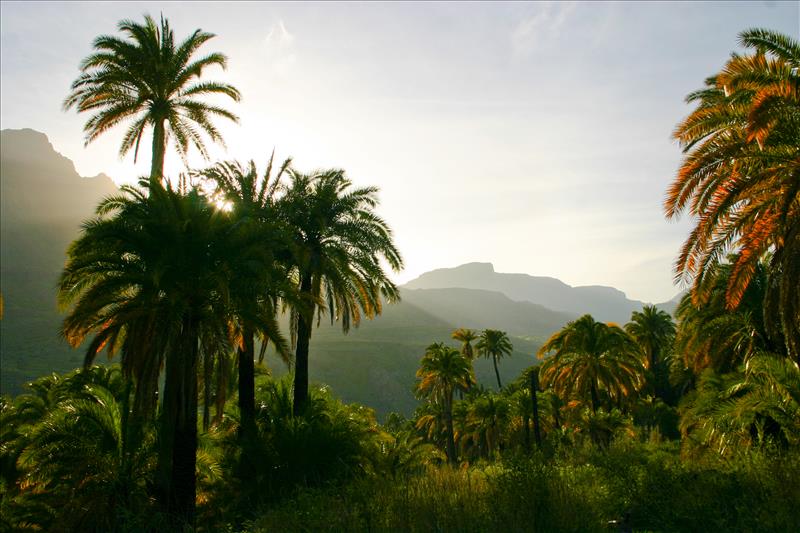
Views from Sorruedo on the Canary Isle of Gran Canaria.
Travel Guide To The Spanish Canary Islands
Basic Information on Spanish Islands
To put them on the map, the Canary Islands are situated in the Atlantic Ocean off the coast of northwest Africa not far from the Sahara Desert as the crow flies. The sunny subtropical climate makes this the perfect latitude for a holiday any time of year.
In contrast, the Balearic Islands lay closer to Spain’s coastline in the Mediterranean Sea which means the weather is seasonal – hot sunshine in summer, warm enough in spring and autumn but somewhat unpredictable although reasonably mild in winter (a bit chilly to lounge by the pool though).
Spain has 3 other small inhabited islands, all of which attract visitors in summertime. Illa d’Arousa and La Toja -part of the picturesque seaside resort of O’Grove– are in Galicia, northwest Spain. Both are connected to the Pontevedra coast by bridge. Tabarca is anchored in the Mediterranean, just off the shores of Alicante on the Costa Blanca, and easily reached by boat.
The Canary Islands are habitually bright and sunny, with a warmer climate than mainland Spain they can be enjoyed year round and are only a couple of hours or so away by plane.
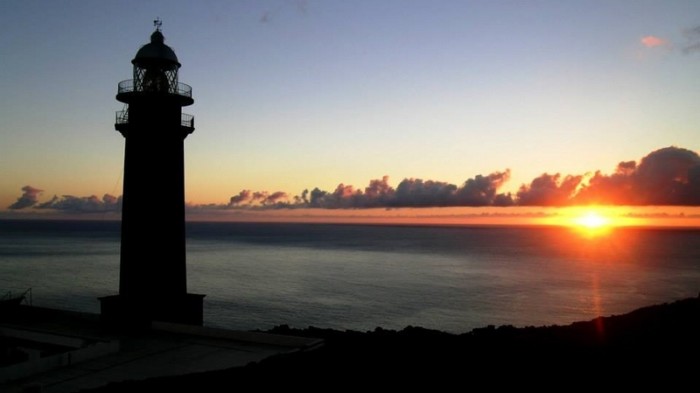
Sunset over the Atlantic Ocean seen from Orchilla Lighthouse, El Hierro Island, the most westerly point in Spain.
Photo courtesy Enseñar El Hierro Canarias España
Ancient History of the Spanish Canary Islands
‘The Canary Islands were once believed to be the remains of the sunken continent of Atlantis and the Guanches direct descendants of the Atlantians.’
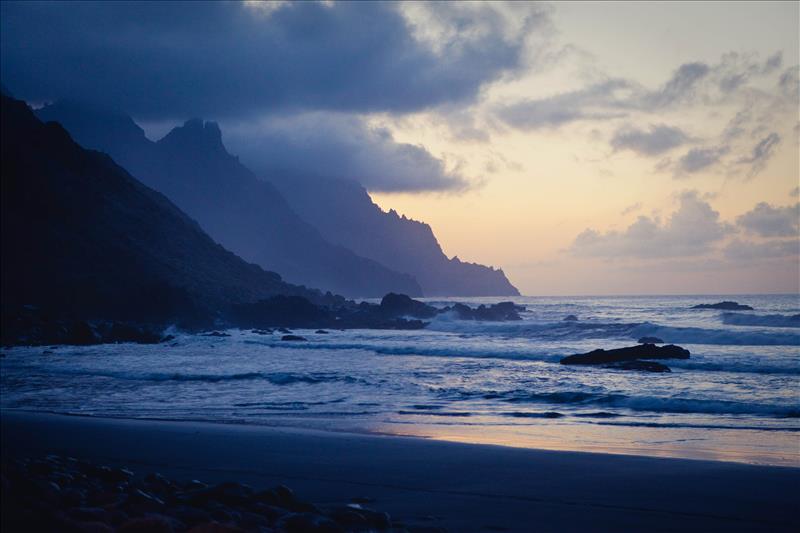
Long before history was actually recorded tales of the Canary Islands were legend; a mythical kingdom to be found beyond the Pillars of Hercules, through the Straits of Gibraltar on the way to the ‘Dark Sea’. Classical authors sited ‘Paradise’ here, the elusive ‘Elysian Fields’ or ‘Garden of Hesperides’.
Adventurers spoke of ‘Nivaria’ and the awesome snow-tipped peak rising above the clouds, ancient stories in fact of Tenerife and Mount Teide. They called the islands ‘Canines’ after the fierce hunting dogs who roamed the lands. The native Guanches, ‘giants dressed in animal skins’, lived isolated from the rest of the world as they were not, apparently, a seafaring people.
The Canary Archipelago consists of the seven major islands -Tenerife, La Gomera, La Palma, El Hierro, Gran Canaria, Lanzarote and Fuerteventura- and several minor ones (Alegranza, Montaña Clara, Roque de Este and La Graciosa located off Lanzarote, and Isla de Lobos to the northeast of Fuerteventura).
Exploring the Canary Isles it’s easy to become fascinated with volcanoes. The islands began forming as shifting continental plates caused volcanic eruptions on the oceanic crust over 60 million years ago, Fuerteventura being the oldest.
1. TENERIFE Travel Guide
Tenerife is the largest of the Canary Islands and famous for it’s volcanic peak Mount Teide the highest point in Spain (3718m).
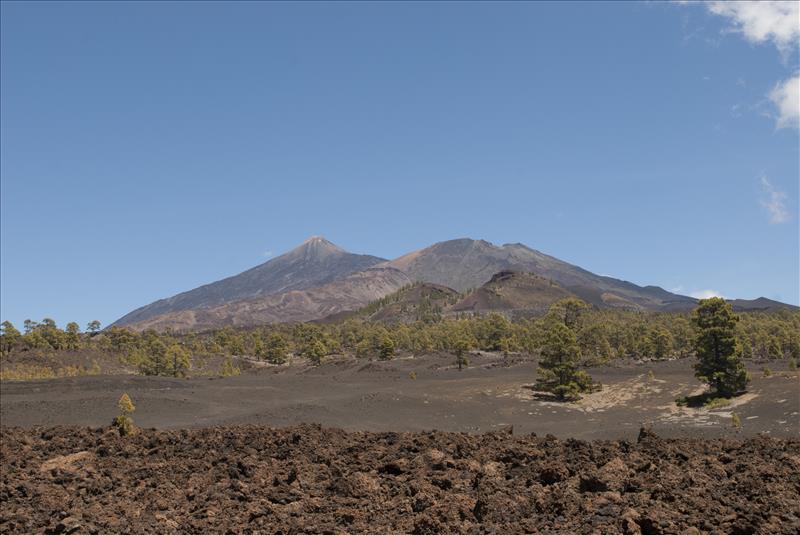
Teide National Park, Tenerife.
North Tenerife
Puerto de la Cruz is Tenerife’s traditional resort, the picturesque seaside town where wealthy Europeans ventured for an exotic holiday in the mid 1900’s before beaches or the Caribbean came into fashion. Elegant hotels in an old town bright with potted flowers still have those typical wooden balconies and the original restaurants, which overhang the black cliff face, that old-fashioned kind of classy décor.
The unchanging backdrop of Teide volcano piercing the sunshine makes this the same postcard perfect picture that great aunt Doris sent home to the family in chilly England all those decades ago.
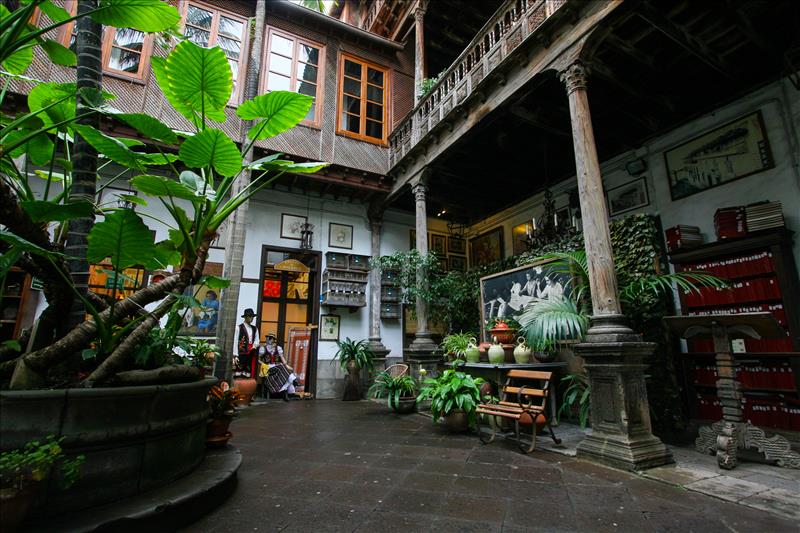
Casa de los Balcónes typical Canarian house in Puerto de la Cruz.
The Costa Martiánez seafront lido makes up for the lack of sand, the immense seawater lake surrounded by more swimming pools, sundecks and exotic gardens with cascades, Jacuzzis and cataracts, is just steps away from the Atlantic Ocean. Puerto de la Cruz’s 18th century Botanical Gardens and Loro Parque wildlife ‘parrot park’ are the must-sees for nature lovers.
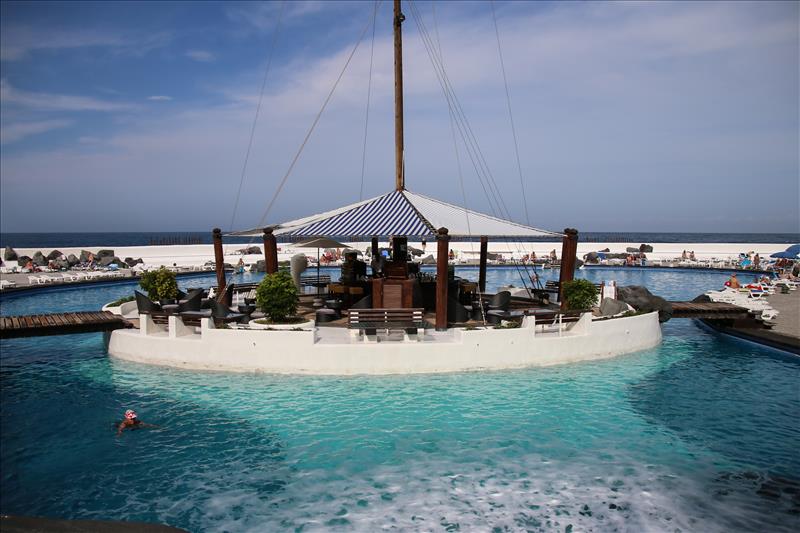
Lago Martianez seafront pools in Puerto de la Cruz, Tenerife.
The town’s varied selection of international restaurants make a change from hotel cuisine and a healthy night-life to suit most tastes feature terraces with live music, open air cafes where you can watch folkloric dancers, trendy pubs and even a real Cuban cocktail club where salsa lessons are part of the fun.
Santa Cruz is the capital, a busy port city on the northern tip of Tenerife. Las Teresitas manmade sandy beach, shopping malls and the glitzy Carnival annual celebration are some of the attractions.
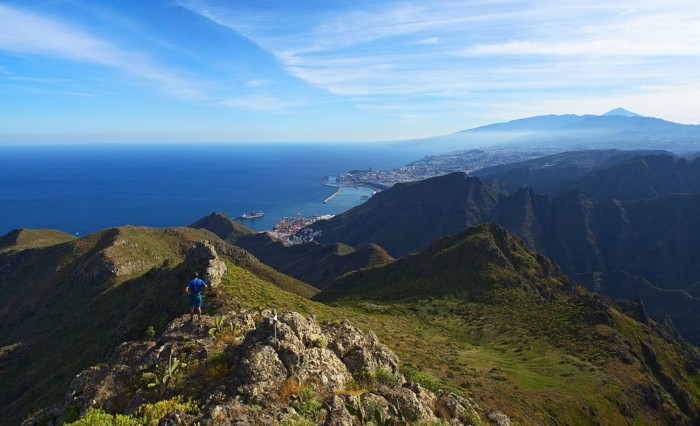
Views to Santa Cruz Bay, Tenerife. Photo courtesy Javier Sanchez Portero / CC BY-SA
The Canary Islands have a special tax free status, meaning consumer goods cost up to 21% less. Car hire and petrol are consequently cheaper. However, purchases must be declared at customs on return to mainland Spain, and on entering your own country, so it’s virtually impossible to sneak out with a sports car or diamonds!
South Tenerife
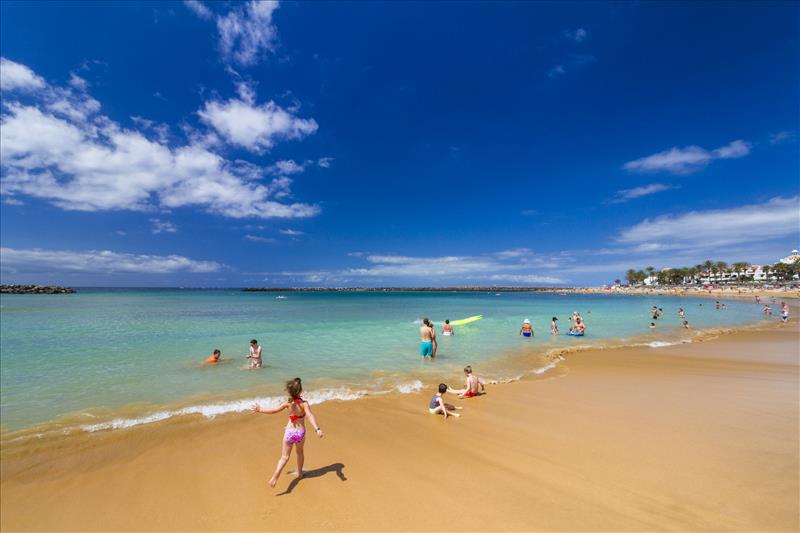
El Camisón beach in Arona, south Tenerife.
While weather in the north of the island is almost tropical (expect a cooling downfall) the far south is pure sun and fun. The southern Tenerife seaside resorts are a modern-day invention, geared to beach life and the entertainment scene.
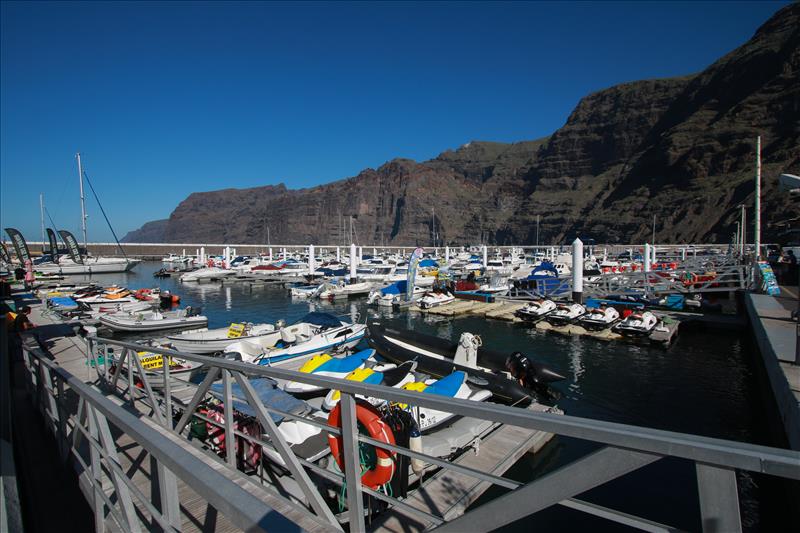
Los Gigantes, Tenerife.
English is the second language! Costa Del Silencio, Los Cristianos, Playa De Las Americas, Costa Adeje or Los Gigantes are the places to look out for. Attractions include the waterpark and numerous beaches. A variety of island excursions and boat trips are available, including the ferry ride to La Gomera from Los Cristianos harbour.
Inland Tenerife and Mount Teide
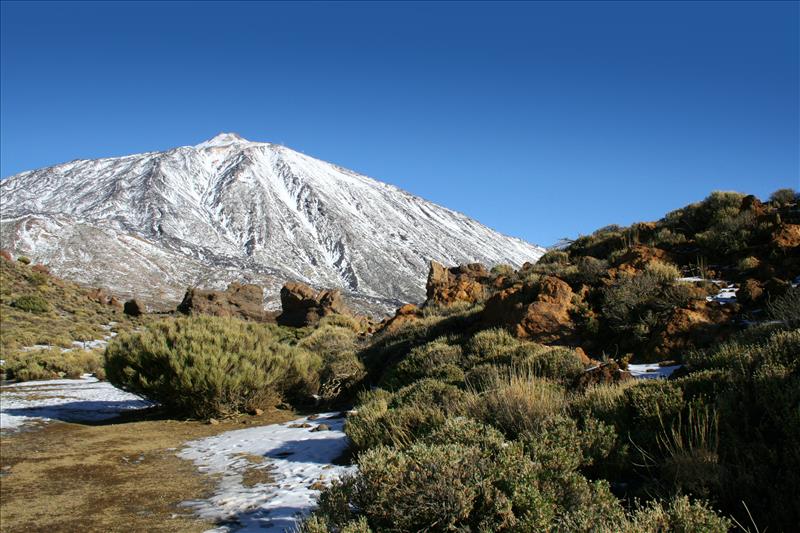
Teide National Park, Tenerife.
The tall peak of Volcano Teide can be seen from everywhere, the lava fields spilling down from the centre of the island. Protected parkland with a cable car system partway up, the last stretch has to be hiked on foot. This is highest spot in the whole of Spain! The interesting Teide Observatory studies zodiacal light and maps out the galaxy with the best telescopes in Europe.
Advice on How to Get to Tenerife
By Air
Tenerife has 2 airports: Tenerife North and Tenerife South.
There are direct flights to Tenerife from all the Canary Islands.
Direct national flights to Tenerife from various cities in mainland Spain and international flights from several European or North African countries.
By Sea
Tenerife has 2 Ferry Ports: Santa Cruz and Los Cristianos.
Tenerife Ferry Routes sail to Gran Canaria, La Palma, La Gomera and El Hierro.
* A permit is required to hike to Mount Teide summit which can be obtained on the National Parks reservations website.
2. LA GOMERA Travel Guide

San Sebastian De La Gomera with Tenerife and Mount Teide in the distance.
Photo courtesy Andree Stephan – CC BY-SA 2.0.
La Gomera is a green massif which rises like a seamount from the chasm that separates this small island from Tenerife, almost as if it’s been thrown into the sea by one of the legendary giants.
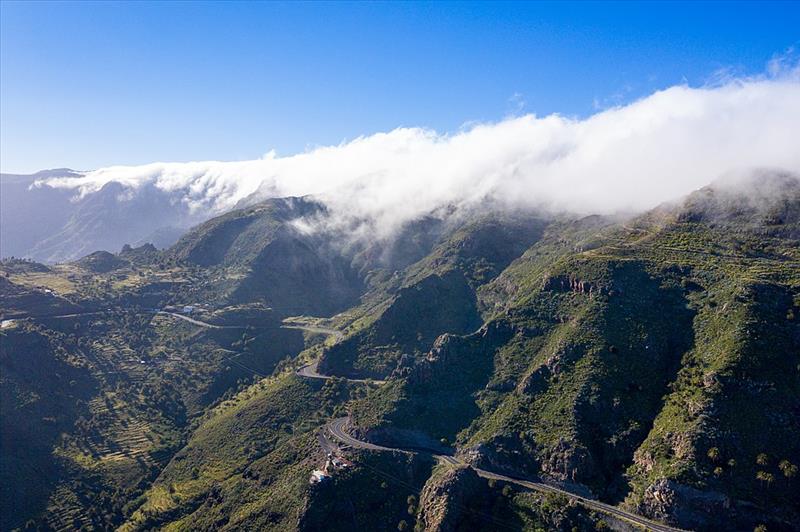
Garajonay National Park in La Gomera. Photo courtesy Luftbild von Straße- CC BY 2.0.
The Magic Island is pure unadulterated nature, mountainous terrain divided by deep gullies swathed with subtropical shrubs and phoenix palm. Forget the holiday crowds on the Canary Costas and take pleasure in hiking the trails, exploring this natural world, stepping across hanging bridges into the misty landscape, like a modern-day Livingstone adventurer.
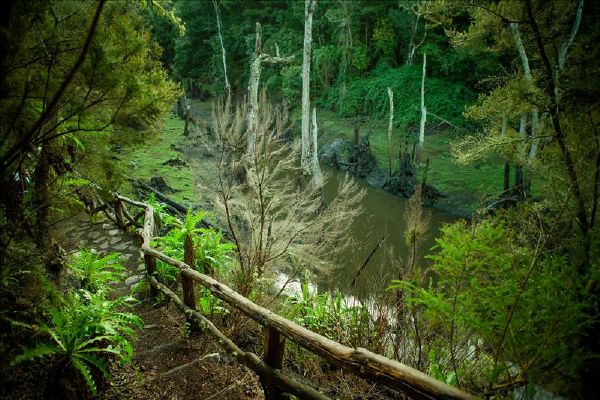
Meriga rain forest trail, La Gomera.
The local ferry leaves Tenerife from Los Cristianos harbour for the short ride over to San Sebastian de La Gomera, a laidback little colonial town sheltered by cliffs.
From here it’s a car or coach ride up to the Garajonay National Park which runs through the central plateau. The mythical Garajonay rock guards the gateway to a rain forest which has been here since Neanderthal man, a biosphere reserve of millennium ‘laurisilva’ laurel trees interspersed with streams, moisture drawn from clouds on their relentless way over the Atlantic Ocean.
Roque de Agando in the Garajonay National Park on La Gomera.
Photo courtesy dronepicr – CC BY 2.0.
Valle Gran Rey is the most popular place to stay on the island. A landscape of volcanic rock encloses a steep sided valley leading down to whitewashed hamlets, a natural harbour, and a string of black sand beaches.
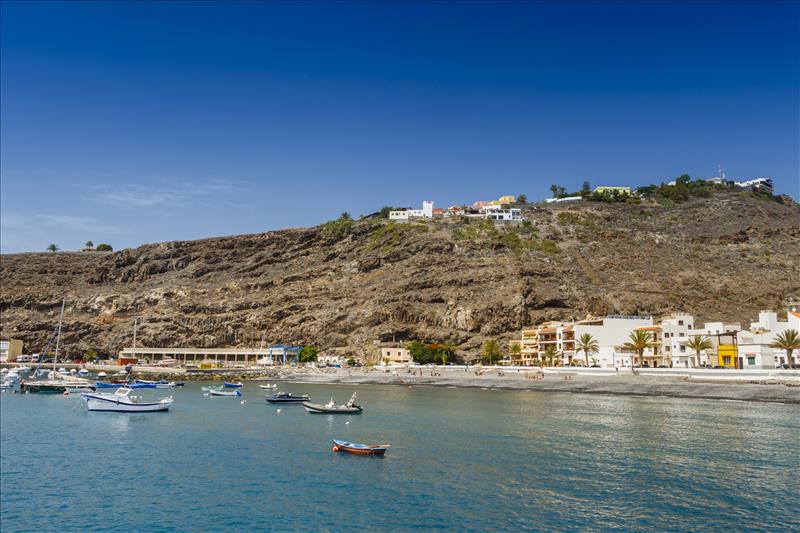
Puerto Santiago in La Gomera, Canary Isles.
Playa de Santiago is another favourite with holidaymakers, a typical fishing village where you can dine on freshly caught seafood in the evenings. Surrounded by terraced fields and with the longest beach on the island, this corner of La Gomera makes an idyllic getaway.
Advice on How to Get to La Gomera
By Air
Direct daily flights to La Gomera Airport from Tenerife and Gran Canaria.
To get to La Gomera from mainland Spain or other European countries you will need a connecting flight.
By Sea
Daily ferries from Los Cristianos, Tenerife.
A local ferry service goes around La Gomera Island between San Sebastian, Playa de Santiago and Valle Gran Rey.
3. LA PALMA Travel Guide
The Island of La Palma is one of the least known and most naturally beautiful destinations in Canaries, and possibly the whole of Spain. La Isla Bonita, Canary’s ‘lovely island’ is virtually unspoiled by tourism so far, a high central spine running from north to south formed by a succession of volcanoes, with pine clad slopes and banana plantations that almost reach down to the sea.
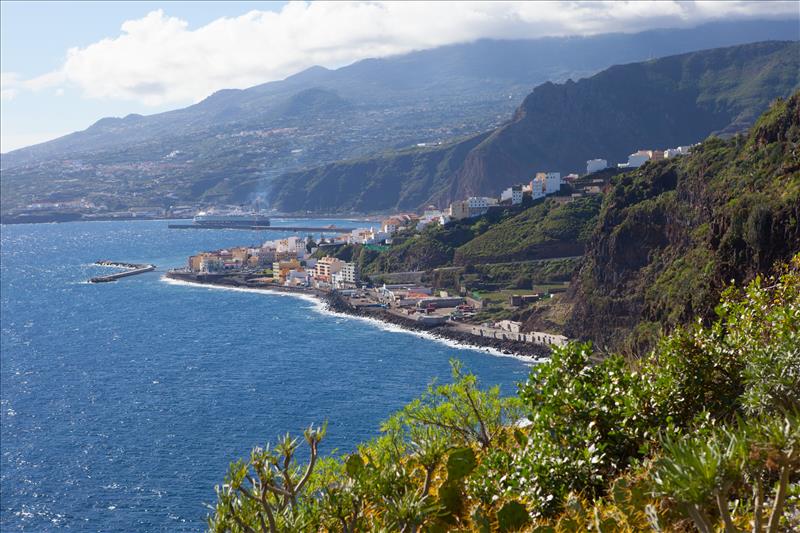
Panaoramic views over La Palma coastline.
The views from any point of La Palma are spectacular. The most convenient and exciting way to explore this fascinating island is to hire a car although organized tours are available.
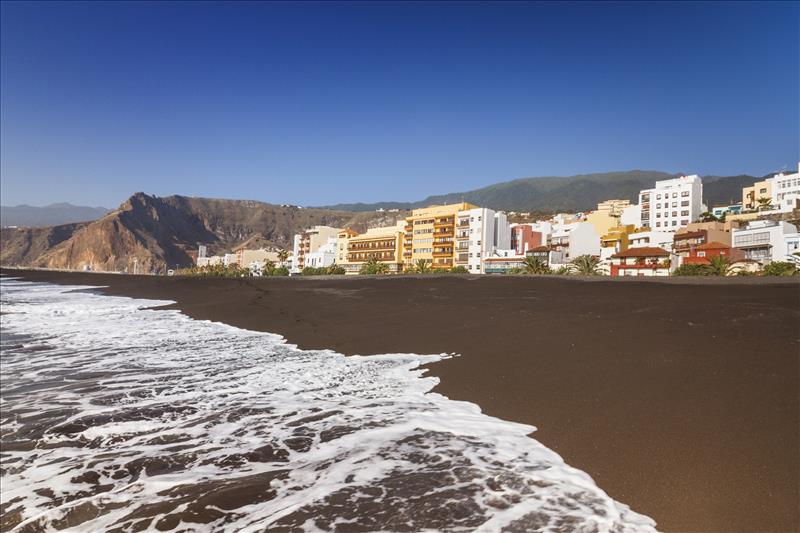
Santa Cruz de La Palma beach.
Santa Cruz de la Palma is the capital, an authentic colonial city with wooden balconied houses and cobblestone roads that lead down to the port, facing towards Tenerife in the distance. There is a black sand bay at the small quiet vacation village of nearby Breña Baja, and a lengthy stretch of manmade beach at the busy colourful resort of Tazacorte over on the west coast.
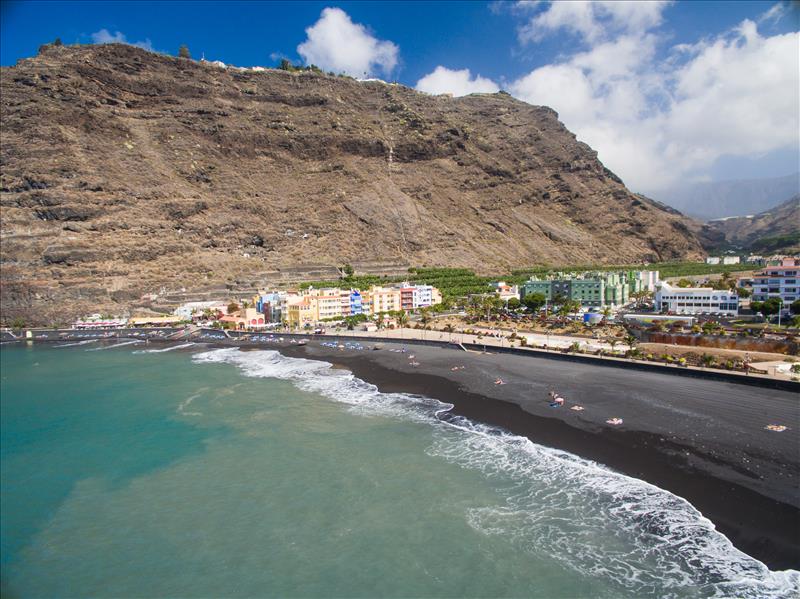
Tazacorte on the west coast of La Palma.
Natural sea pools on the rocky coastline are ideal for swimming and part of the enchantment of coming somewhere different. And La Palma is definitely unique! Dining inside a volcanic tube is a pretty rare experience, for example – platters of homemade sausage and goats’ cheese are served with the local wine in an unusual bodega by the lava fields.
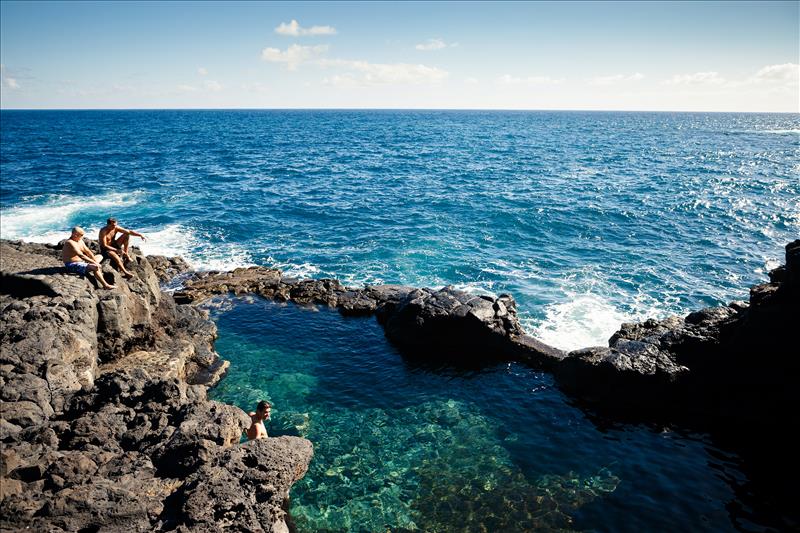
Charco Azul seawater rock pools, La Palma.
Come prepared with hiking boots to discover some of the natural wonders. Los Tiles ancient laurisilva rain forest is a UNESCO Biosphere Reserve and a walkers’ lost paradise; the exotic Caldera de Taburiente National Park, a huge volcanic crater replete with pine trees and cascading water.
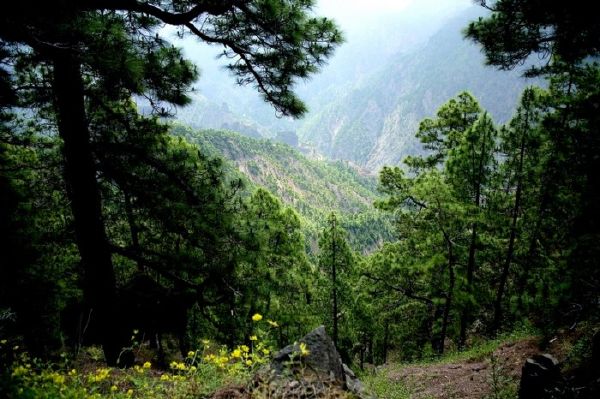
Caldera de Taburiente crater, La Palma Island.
Carry on down to Fuencaliente at the southern tip of the island where the Cumbre Vieja volcanic ridge ends at Teneguia, the cone that erupted back in 1971.
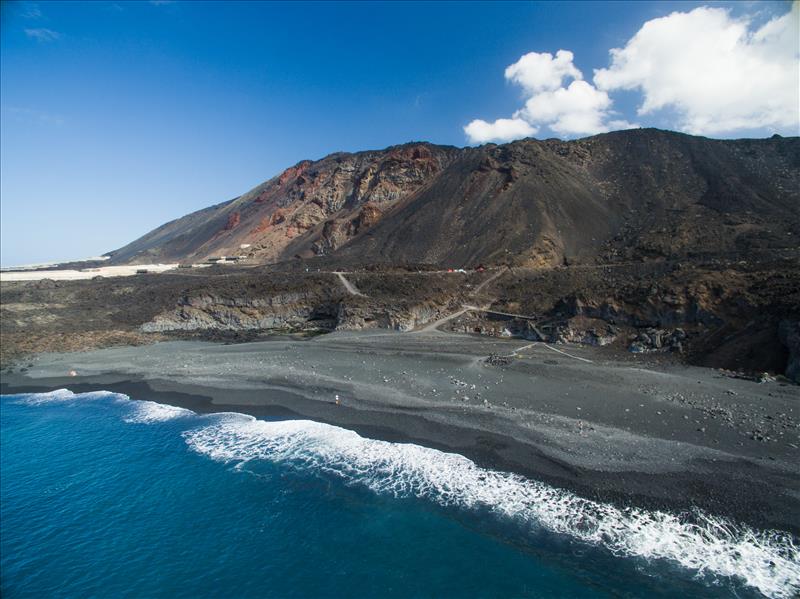
Echentive ‘new’ beach Echentive ‘new’ beach under Fuencaliente Volcano, La Palma Island.
Finally drive up through pinewoods to Roque de los Muchachos 2,423m above sea level, to where an astronomical observatory monitors the universal skies and the panorama is utterly stunning.
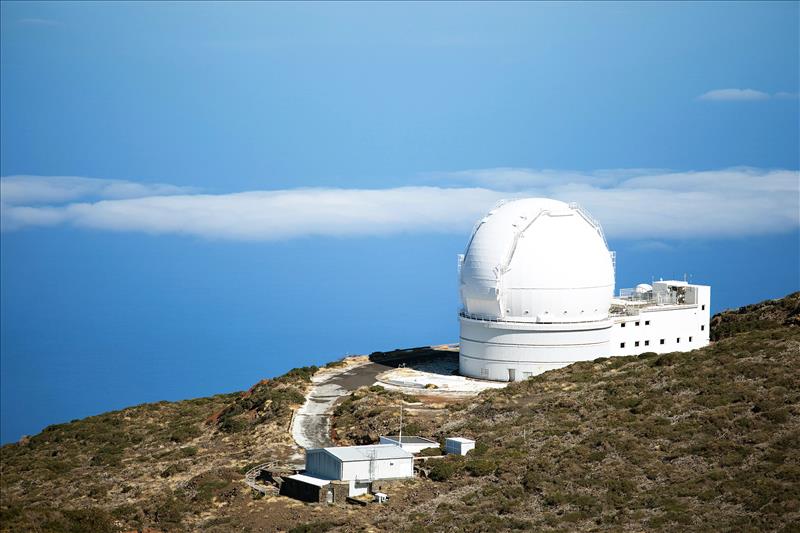
Roque de los Muchachos space observatory, La Palma.
Advice on How to Get to La Palma
By Air
Direct daily flights to La Palma Airport from Tenerife and Gran Canaria.
There are direct flights to La Palma from Madrid and Barcelona, to get to La Palma from other destinations in mainland Spain you will need a connecting flight.
Direct international flights from the UK, Belgium, Germany, Holland, Poland, France and Scandinavia.
By Sea
Daily ferries connect La Palma with Los Cristianos, Tenerife.
La Palma Volcano Erruption
The latest volcanic erruption in the Canary islands occurred on La Palma. The Cumbre Vieja volcano errupted violently on the island of La Palma, on the afternoon of September 19, 2001, after nearly 50 years of lying dormant. Almost 3 months later the volcanic activity and earth tremors ceased.
Thousands of earth tremors over the previous 2 weeks warned of the eminent erruption which finally took place around 15.10 (GMT+1) on Sunday the 19th of September, 2021. Several vent mouths and volcanic fissures spewed out molten rock towards Los Llanos de Aridane valley and the popular coastal resorts of Tazacorte and Playa de Puerto Naos, over the following three months.
The intense lava fountains could be seen and heard from miles around. Dozens of small earthquakes were felt everyday at different points of the island, the biggest of magnitude 5.1 which occurred some 30 kilometres south east from Los Llanos de Aridane.
More than 7,000 local residents, as well as livestock, were evacuated in precaution from possible danger zones. Although the erruptions have been occuring in an unpopulated area away from villages and towns, the flowing lava engulfed more than 3000 homes, as well covering banana plantations and other agricultural land which lay in its path.
On December 25th 2021, volcanologists confirmed that the volcano has ceased activity and is now considered to be dormant.
While 10% of the island has been affected by the volcanic activity, the majority of roads and walking trails are now open (check which routes are closed on La Palma). The main areas affected are on the west coast, particularly Llanes de Aridane.
4. EL HIERRO Travel Guide
Shoals of multicoloured fish play among corals in a clear azure ocean which bathes iridescent black shores where the darkest of cliffs rise to bright blue skies, meanwhile the isle hides aquamarine pools and green primeval forests from strangers’ sight. El Hierro’s artistic palette spills from volcanic peaks as the setting sun stains the horizon deep orangey-pink and an indigo twilight shimmers with a million silver stars.
El Hierro is one of the best places in the world, according to National Geographic! Not your usual sun, fun and merrymaking Spanish resort, El Hierro is an entirely different and nature loving experience.
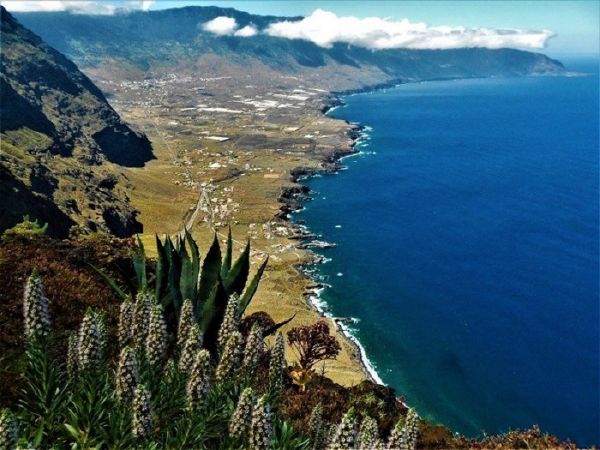
Valle Del Golfo seen from Mirador de la Peña, El Hierro.
Photo courtesy Enseñar El Hierro Canarias España
El Hierro is a UNESCO Biosphere and Marine Reserve, and a Global Geopark. Leading the way in sustainable living, the island is powered by hydro-wind electricity and eco-friendly tourism rules. A ‘Smart Island’ entirely connected to the world with free wifi, the local philosophy combines the best of traditional and modern worlds.
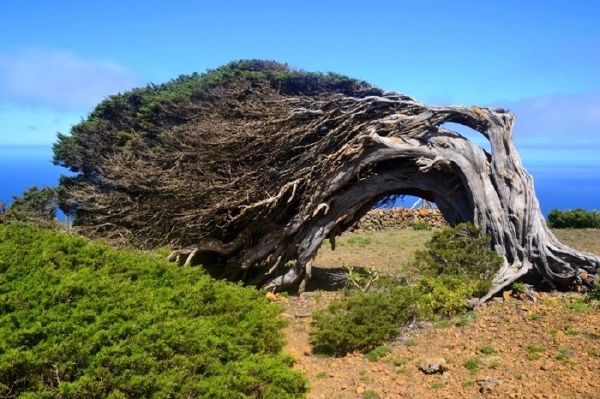
Juniper tree at La Dehesa De La Frontera, El Hierro.
Photo courtesy Enseñar El Hierro Canarias España
A two-and-a-half ferry ride away west of Tenerife and all on its own in the Atlantic Ocean, El Hierro is not exactly a crowd puller but a well kept secret!
A contrasting landscape -envision high coastal cliffs and deep inland valleys, meadows and lava fields, a network of hiking trails with panoramic views, stunning natural swimming pools cupped in volcanic rock- and a varied ecosystem where evergreen laurel and pine forests prevail, palms shade the sunny slopes and junipers twisted by centuries of sea breeze embody the island’s solitary spirit.
Sounds gorgeous doesn’t it? But this only part of the charm, the thrilling undersea world and abundant marine life are the real allure.
Best Canary Island For Diving
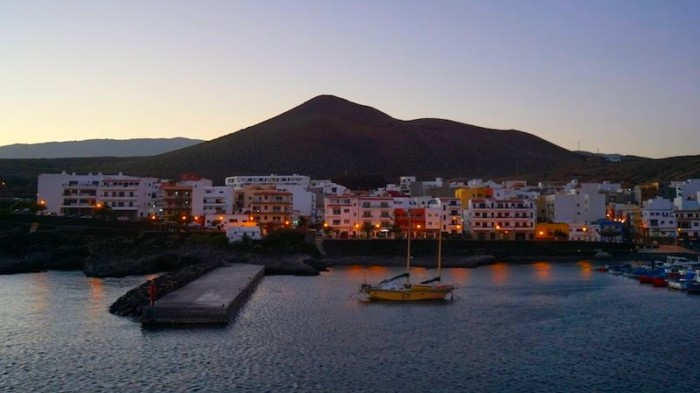
La Restinga at sunset. Photo courtesy Christian Oliveira Random Trip
La Restinga is the fishing village on the south coast where the dive schools are based, typically quaint and a great place to stay. The weather is ideal for diving any time of year and visibility is good. One of the best dive sites in Europe, Mar de la Calmas Marine Reserve is located just off the coast.
The diversity of marine life is quite extraordinary, the sub-aquatic world of rocky pinnacles, tunnels and grottos an underwater playground where parrot fish, seahorses, angel sharks, dolphins, turtles thrive. The seabed abruptly drops down 300 metres to volcanic rocks where you’ll see sponges and anemones on the yellow and black corals, and other little creatures that inhabit the deep.
Beaches and Sea Pools of El Hierro
‘The Beaches’ are 9 kilometres of black sand and pebble coves that circle around the practically virgin coastline. Playa de Arenas Blancas is the only ‘white beach’ on the island, the sand made of crushed seashells which together with the surrounding lunar landscape give a truly exotic effect. Playa de Tacorón is a small red sand beach whose added attractions are the natural sea pools.
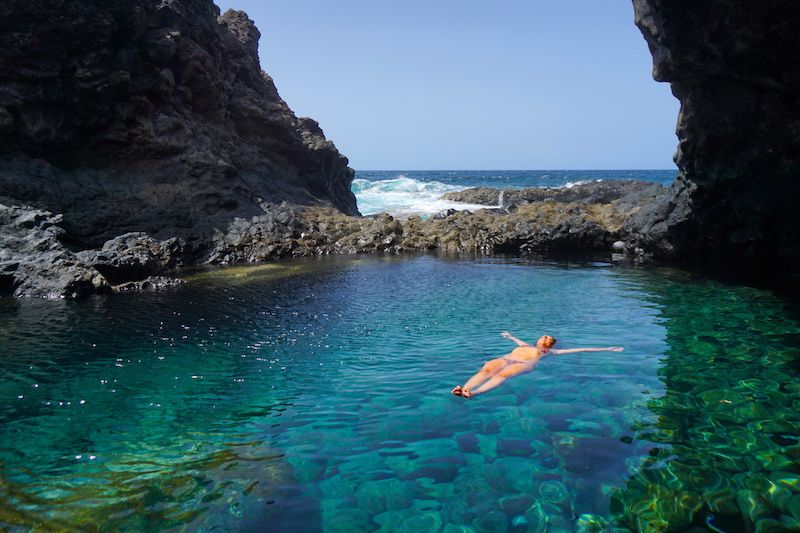
Charco Azul sea pool, El Hierro. Photo courtesy Christian Oliveira Random Trip
Pop along to the volcano interpretation centre to learn how the island formed over millions of years and the more recent sub-aquatic eruption 2011, the latest volcanic activity on El Hierro.
Valverde is the only inland town and the capital of El Hierro, built some 700m up the mountainside it has impossibly steep streets, a historical 18th century church and a local cheesecake factory. The island’s airport is 15 minute bus ride away down on the Costa de los Cangrejos coast.
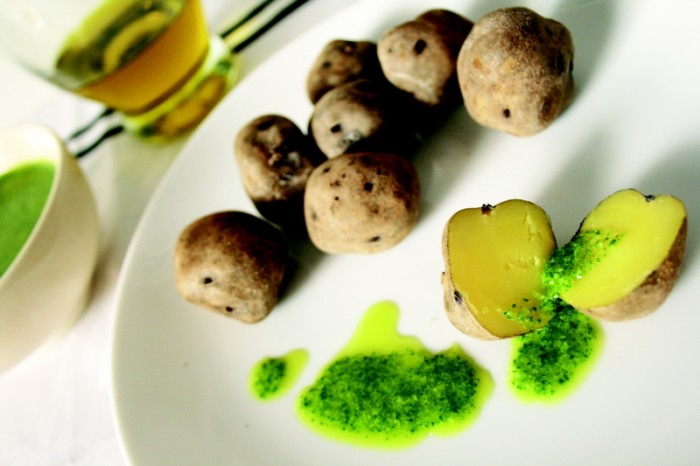
Papas arrugadas con mojo verde, a typical Canary Isle appetizer.
Talking about food, El Hierro’s produce is sustainable too. Typical ‘papas con mojo’ (those tiny potatoes cultivated in volcanic soil, then boiled and served with spicy sauce), thick vegetable soups, seafood rice and fresh fish are culinary favourites. Rabbit and goat are the specialties for those who eat meat. Figs, grapes and dates are the fruits of the land, the local wine and cheese a treat!
Advice on How to Get to El Hierro
By Air
Direct daily flights to El Hierro Airport from Tenerife and Gran Canaria. From other destinations you will need a connecting flight.
By Sea
Daily ferries from Santa Cruz or Los Cristianos in Tenerife, and from La Gomera.
5. GRAN CANARIA Travel Guide
Gran Canaria is sometimes called the ‘mini continent’ due to the great diversity of landscape and climate. It is almost circular in shape with sandy beaches that enjoy year round sunshine and a mountainous interior.
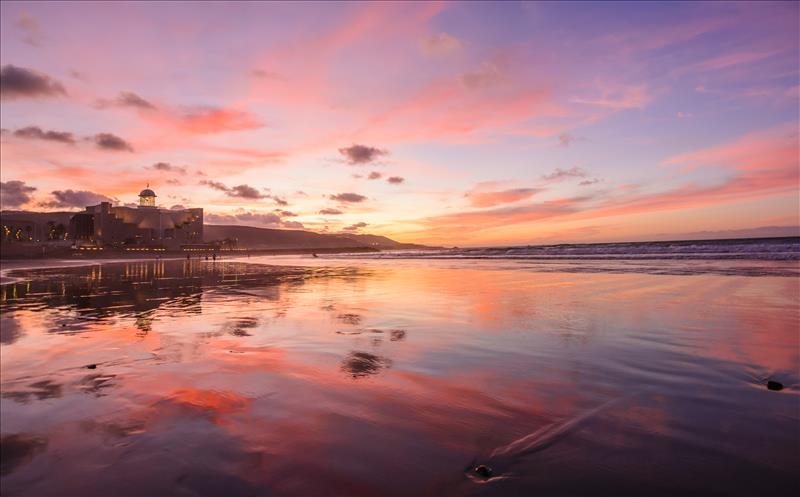
Sunset over Las Canteras Beach in Las Palmas, Gran Canaria.
Las Palmas is the busy port city capital on the northern tip, Barrio de Vegueta the historical part of town, Las Canteras the famous urban beach.
South Coast of Gran Canaria
Down south is the mega tourist resort of Playa del Inglés, known as one Europe’s favourite LGBT destinations it’s also a great clubbing town with fabulous beaches.
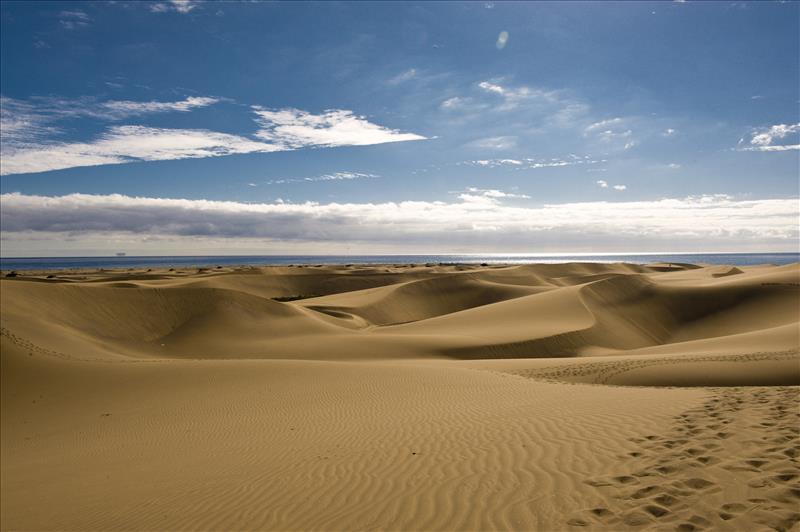
Maspalomas sand dunes, Gran Canaria.
The vast dunes of Maspalomas remain remarkably untouched by time, a desert-like eight kilometre strip of undulating golden sands that reach along to the sea (nudism allowed in the central stretch). Continue on to the lively but more family orientated Puerto Rico, a holiday village built around a sandy bay just bursting with life.
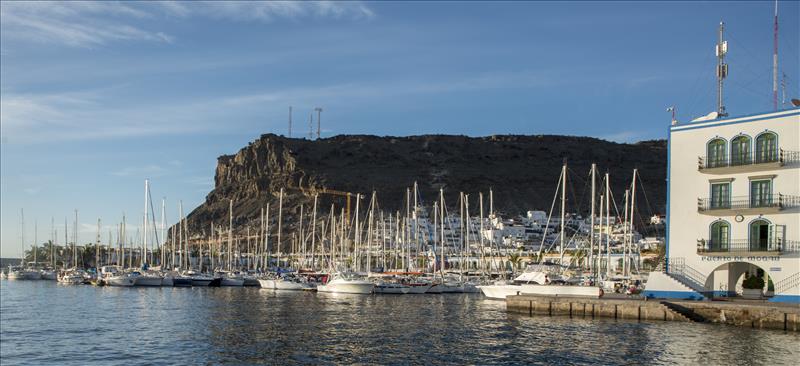
Puerto de Mogán marina, Gran Canaria.
Puerto de Mogán is a picturesque harbour far south, way down below the cliffs with bougainvillea-covered, whitewashed traditional fishing cottages that are linked by canals. The yachting marina is lined with classy restaurants, just round the corner from a fine sand bay.
Inland Gran Canaria
Inland from here the mountainside is rugged and dry with tiny remote villages which seem lost in time. A drive along twisting roads up through the clouds eventually leads to Cruz de Tejada, the huge mountain in the heart of the island. Nearby is Roque Nublo, a volcanic monolith which symbolizes Gran Canaria.
From here the contrast is evident as the road twists down through forest and green valleys where precarious footpaths lead to difficultly accessible cave houses where folk still live. Visit in springtime to walk the trails near Valsequillo and Tejeda, as this is one of the prettiest areas to see almond blossom in Spain.
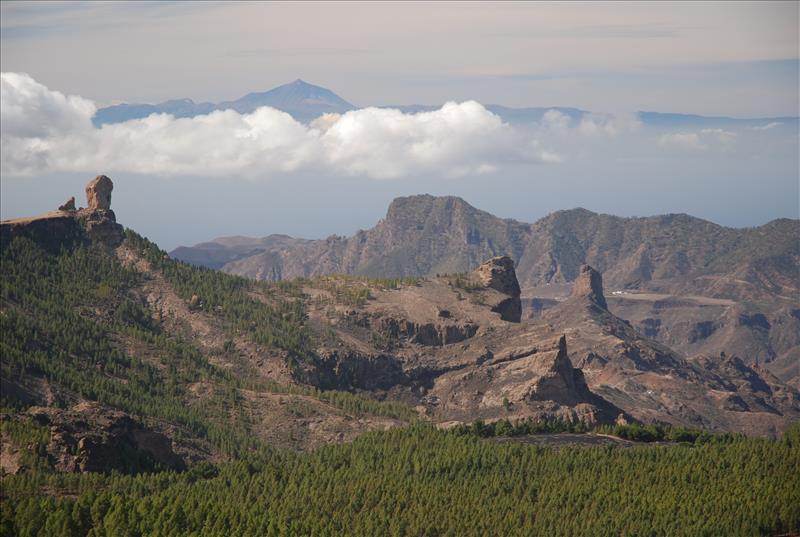
Roque Nublo and Cruz de Tejada peak, Gran Canaria.
Valleseco is something else again. The name means the ‘dry valley’ which is curious because rain falls constantly all year. Long strips of bark hang down from the giant trees giving an eerie ghostly effect though the dripping mist. The small town of Teror is hidden away in the folds of the mountainous countryside, traditional Canary style houses anchored either side of a ravine in a gravity challenging feat.
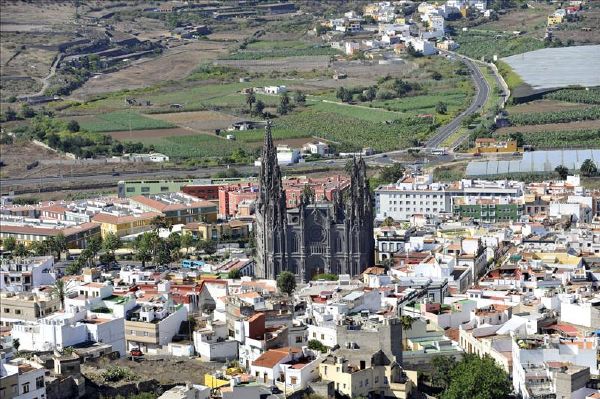
Arucas cathedral, Gran Canaria.
Arucas is a typical town in a rural setting surrounded by banana plantations not far from the capital. A monumental ‘Cathedral’, a local rum distillery and the Mirador de la Montaña viewpoint the main claims to fame. Caldera de Bandama is a large ‘cauldron’ crater a kilometre in diameter by 200 metres deep created by volcanic activity. A narrow path leads to a plain below where the isolation of the people who farm the land gives life to local legends.
West Coast of Gran Canaria
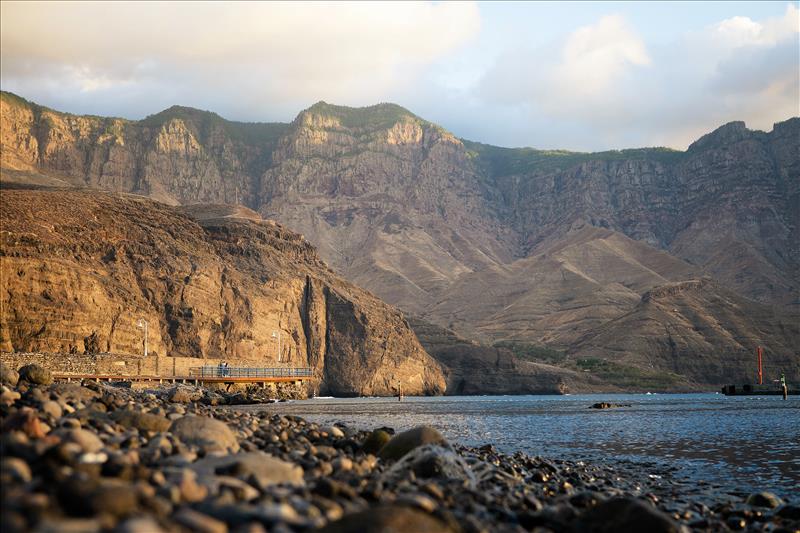
Agaete harbour on the west coast of Gran Canaria.
The Agaete coastline lies on the western side of the island, inpenetrable dark cliffs facing the Atlantic Ocean and the best place to sip a cool beer from the deck of a beach bar beside the harbour while watching the sun set over the Atlantic.
Advice on How to Get to Gran Canaria
By Air
There are direct flights to Gran Canaria Airport from all the Canary Islands.
Direct national flights to Gran Canaria from various cities in mainland Spain and international flights from several European or North African countries.
By Sea
Gran Canaria has 2 Ferry Ports: Las Palmas and Agaete.
Gran Canaria Ferry Routes sail to Tenerife, Fuerteventura and Lanzarote.
6. LANZAROTE Travel Guide
The Sunshine Isle
The most north-easterly of the ‘Fortunate Isles’, as the Canaries were once known, and only 125 kilometres from the African Continent, Lanzarote with over 300 volcanoes is extraordinary.
Sculpted by the great volcanic eruptions of the 18th Century from 1730 to 1736, the earth spat fire almost continuously, the lava buried a third of the entire island, whole villages disappeared and what had once been fertile land was covered by lava. This was the birth of the ‘Montañas de Fuego’ – in six years of eruptions more than 100 volcanoes rose up from the flames.
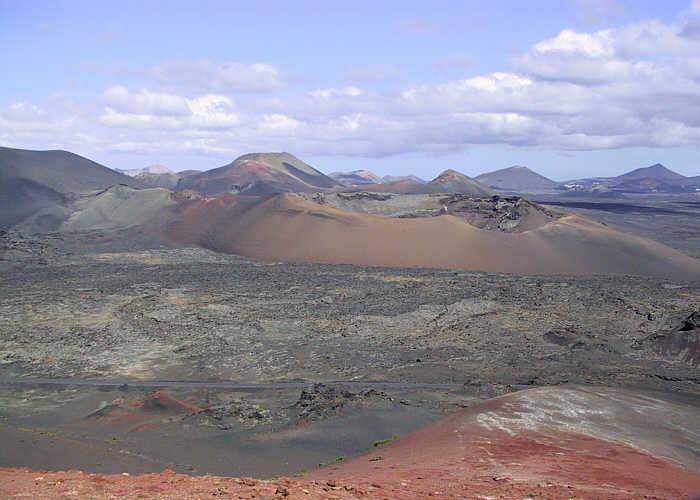
Timanfaya ‘Fire Mountains’, Lanzarote. Photo courtesy Gero Brandenburg – CC BY-SA 3.0.
Volcanic Landscape and West Coast of Lanzarote
Nowadays you can drive up through the surreal landscape on well paved roads to Timanfaya National Park and look into the depths of Fire Mountains. Although it’s obviously touristy, eating something barbecued over a live vent is a pretty unusual fun thing to do!
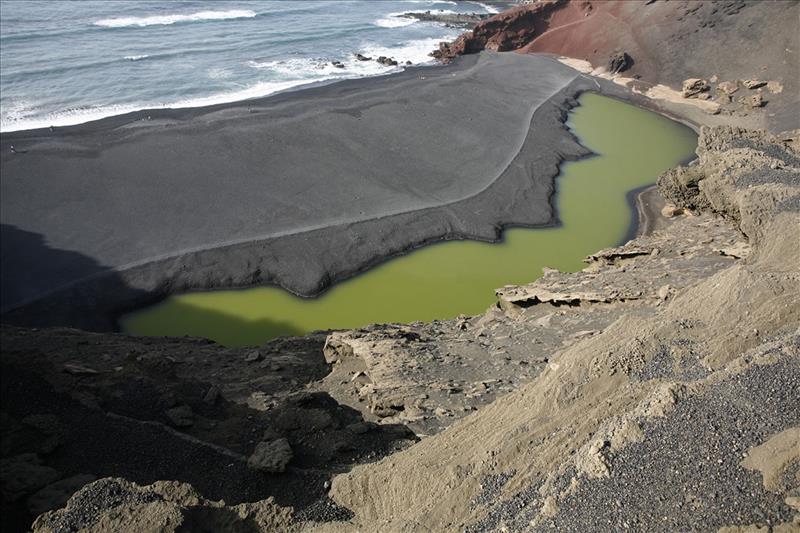
Charco Verde, Lanzarote.
The adjacent coastline has a dramatic beauty too. Sunbeams sparkle off Charco Verde’s olive green waters, a small crater wedged between the ebony cliffs and the ocean. Move on south to Los Hervideros to watch the sea ‘boiling’ an optical effect caused by waves gushing through underwater cavities cut into the molten rock seabed.
The contrast continues south at Salinas de Janubio where salt lakes shimmer whitely against the black shingle beach.
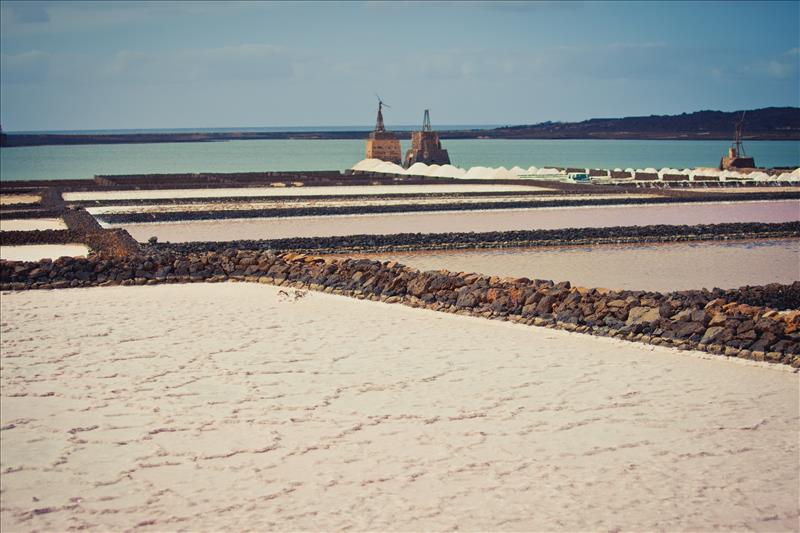
Salinas de Janubio salt lakes, Lanzarote.
The west coast is wild and untamed! To the north, Caleta de Famara is an unpaved fishing village with a tiny harbour and a vast windswept beach which surfers just love. The skyline bright with paragliders sailing over the cliffs and kites flying out at sea.
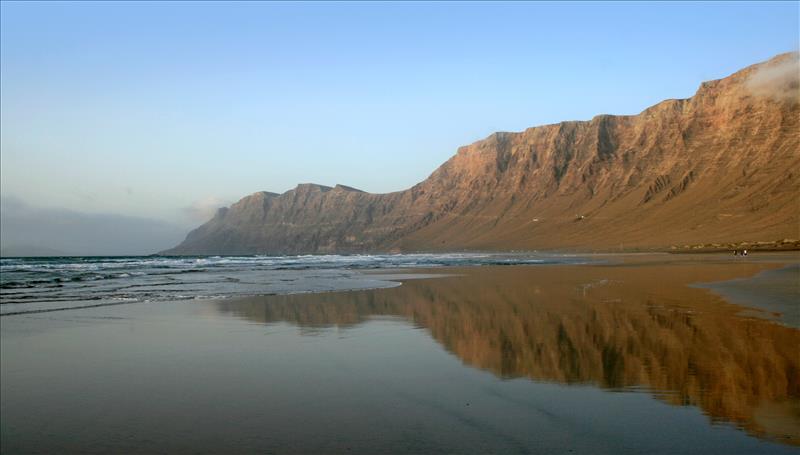
Caleta de Famara, Lanzarote.
Whitewashed inland villages are typically bright with flowers, the locals traditionally making their living from the land. It’s surprising to see how the fields of lava which cover much of the island are used for crops, the barren looking farmland growing fruit and vegetables, and even grape vines!
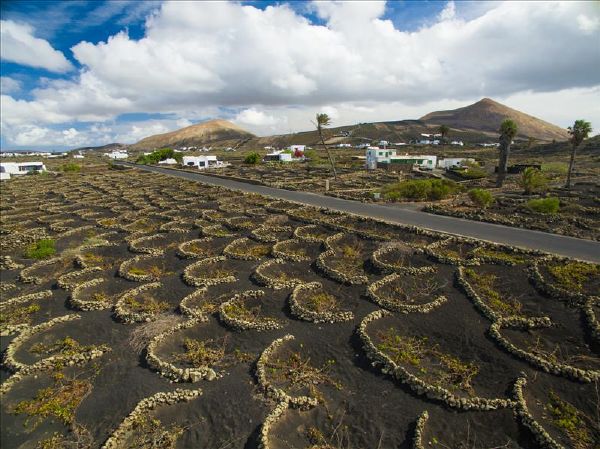
Vine plantations in Lanzarote.
Lanzarote East Coast – The Best Beaches
Puerto Del Carmen is one of the three main resorts on the island, a lively seaside town with loads of eateries and pubs along the promenades, long golden sandy beaches and a little harbour with seafood restaurants. A favourite place to stay with a great holiday atmosphere, you can just walk out onto the beach and swim in the habitually calm sea, and it’s centrally located for exploring the whole island by car or on a coach trip.
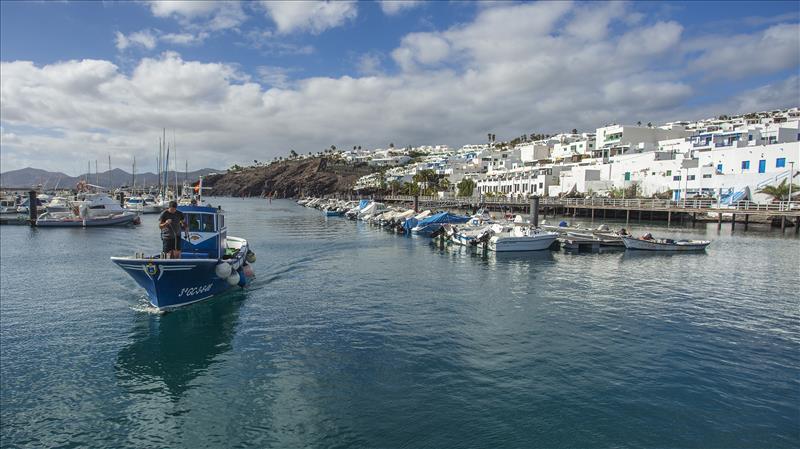
Puerto del Carmen, Lanzarote.
Playa Blanca ‘white beach’ is an indolent southern village facing Fuerteventura which has managed to keep the original charm –you can get a ferry over to see the neighbouring isle. The outlying all-inclusive-holiday complexes are like Caribbean resorts with sunny weather all year to enjoy the exotic pools, but much closer to home and children friendly!
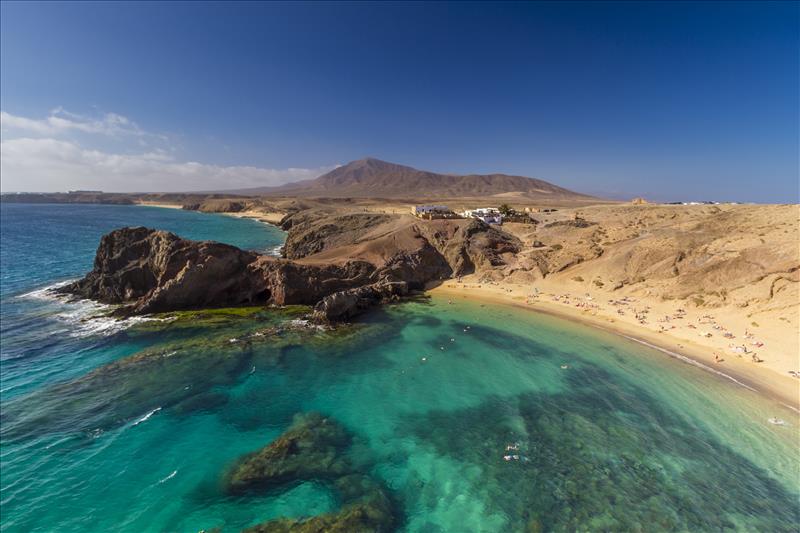
Papagayo Beaches, Lanzarote.
Lanzarote’s best beaches are a walk away at Papagaya Bay. A protected nature reserve, dunes enclose a peaceful succession of seven white-sand bays and shallow aquamarine sea, one of the most perfect settings in the world.
Arrecife is the capital, a busy port city with an ancient fort castle and a history of invading pirates. The coastline continues north along Costa Teguise where there are lots of holiday homes and an endless variety of beaches.
The North of Lanzarote
Volcanic tunnels connect a network of partly explored caves. Cueva de los Verdes is one of these – a guided tour to discover the depths will reveal the dark cavern’s ‘secret’. Jameos Del Agua is part of the same system bordering the sea. The scene has been beautifully set by an underground lake where concerts are held in a natural auditorium.
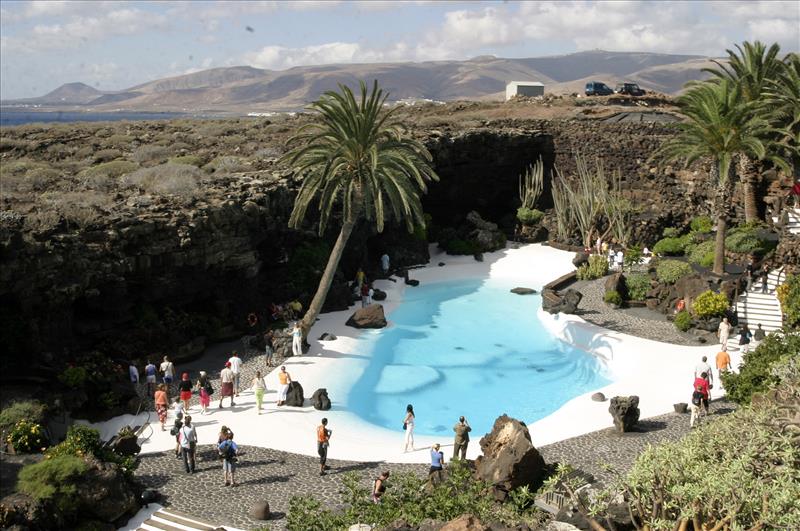
Jameos Del Agua, Lanzarote.
The highlands in the north are greener and reasonably tourist-free. Mirador del Río is the famous panoramic viewpoint over the straits to the Chinijo Isles. Órzola is a busy fishing village which is ideal for a tapas or seafood lunch. Come early to catch the boat over to La Graciosa.
Advice on How to Get to Lanzarote
By Air
Direct daily flights to Lanzarote Airport from Tenerife, Gran Canaria and Fuerteventura.
There are direct flights to Lanzarote from various cities in mainland Spain and several European countries.
By Sea
Daily ferries from Gran Canaria and Fuerteventura.
7. LA GRACIOSA Island
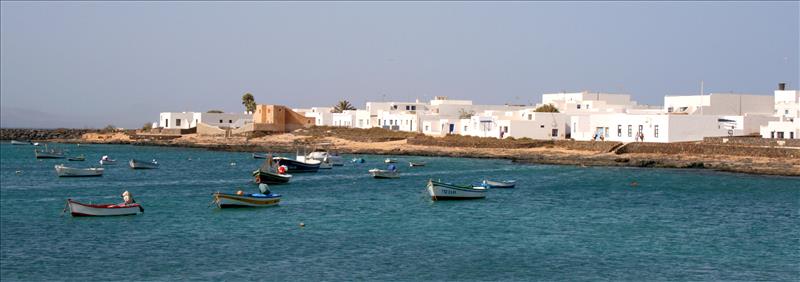
Caleta de Sebo, La Graciosa.
La Graciosa (27 km2) is the smallest inhabited island of the Canaries. A brief boat ride to Caleta de Sebo takes you over to another world, a whitewashed village with sand ‘roads’, where the locals mostly make their living from fishing. Hire a push bike or walk the trails, and then spend a leisurely few hours lazing on the deserted, white sandy beaches.
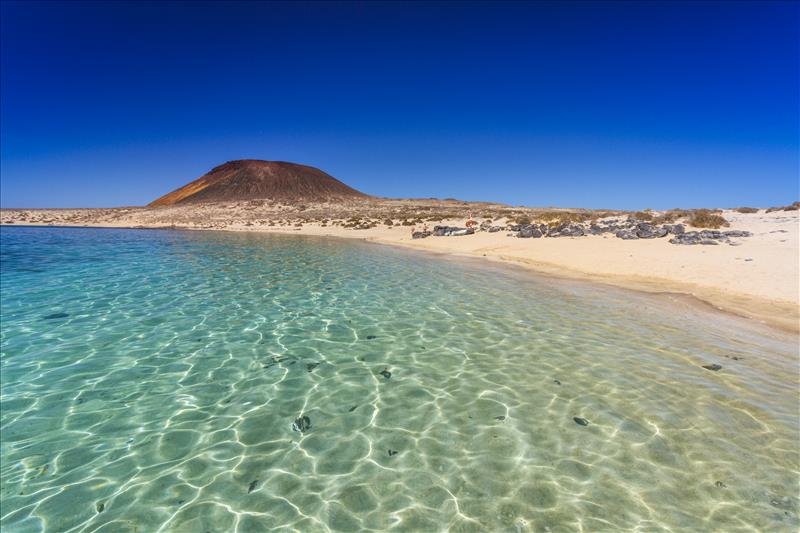
La Francesa beach, La Graciosa.
8. FUERTEVENTURA Travel Guide
Fuerteventura is a haven for the adventurous with immense, deserted, windswept, sandy beaches ideal for water sports. Corralejo, to the north, is a busy resort, while the quieter Caleta de Fuste is a sheltered bay and is geared towards families with small children. The Jandia Peninsula is a wind-surfers paradise.
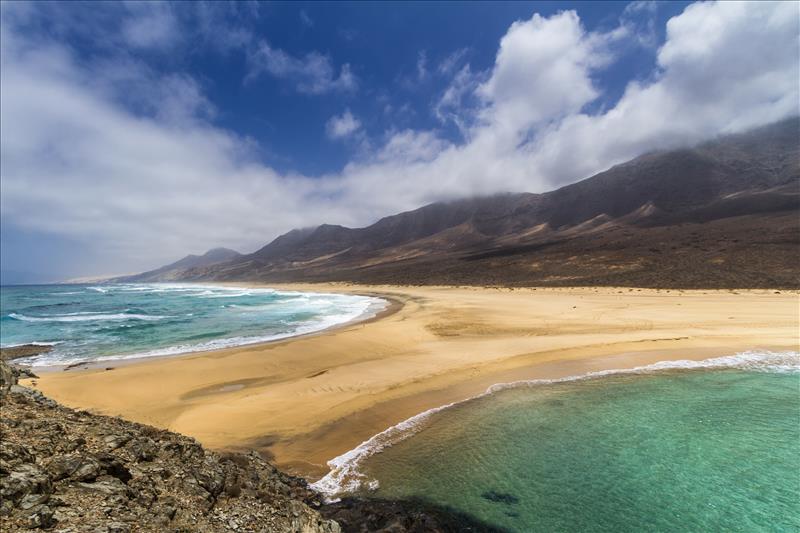
Cofete Beach in the Jandia Penisula, Fuerteventura.
Over 3,000 hours of sunshine a year, 340 kilometres of coastline, 150 beaches, 2 ½ hour flight from mainland Spain, can you ask for more? Fuerteventura is the ‘Fortunate Isle’ where massive stretches of untamed sandy beaches, sheltered bays and solitary coves meet turquoise sea, a paradise for sun worshippers, naturalists and surfboarders of every kind.
Watch the sun rise and set over the ocean, contemplate the undulating landscape of volcanic hills, feel the essence of Fuerteventura, live an adventuresome dream.
East Coast of Fuerteventura
Fuerteventura is a Unesco Biosphere Reserve, yes the whole island and surrounding waters are a nature reserve. How cool is that! One of the Canaries least known isles, it’s avoided mass tourism to date. With a couple of holiday hubs in Corralejo and Caleta Fuste either side of capital Puerto Rosario, and a sprinkling of vacation homes the remainder is vastly untouched.
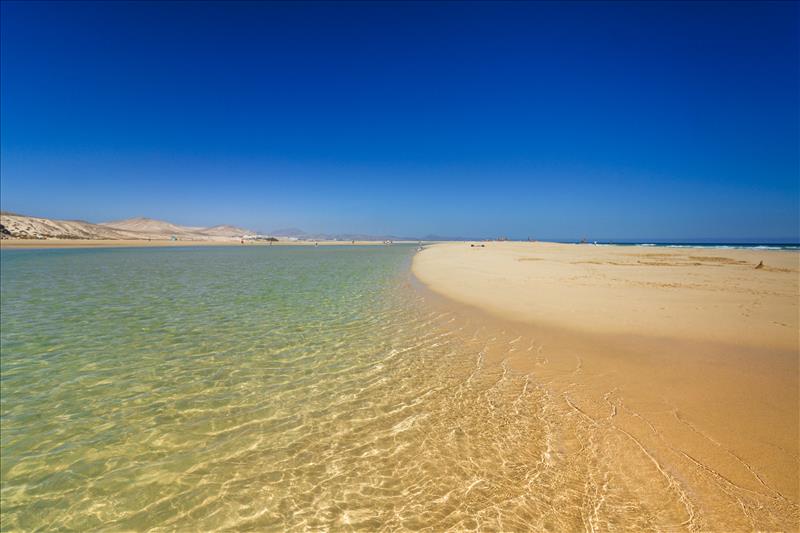
Playa Risco Del Paso, Sotavento Beach.
The endless pale sands of the east coast stretch sweep down from Corralejo towards Puerto Rosario, and the sheltered bay at Caleta Fuste. Jandia Peninsula reaches to the far south, the Alisios trade winds whipping the infinite soft sands along Costa Calma and Sotavento Beach. The paved roads peter out at Morro Jable and off-map real adventure kicks-in along an intrepid coastline where rollers surf beaches and legends are made.
Inland Fuerteventura and the West Coast
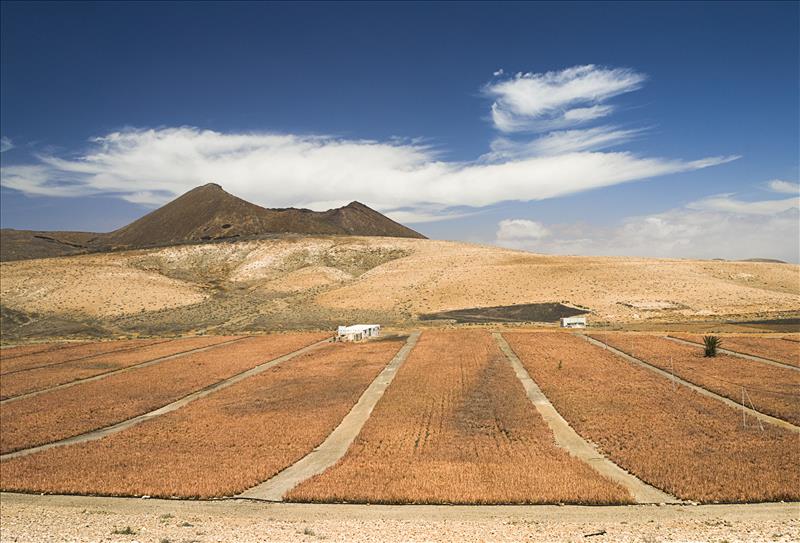
Volcanic landscape on the plains of Tiscamanita, Fuerteventura.
A drive over to the west coast passes palm dappled villages with colonial names, like Antigua or Betancuria, on the way to the darkly dangerous coves of Caleta Negra and Playa de los Muertos. Double back inland over the windmill strewn plains up towards Fuerteventura’s emblematical volcano Tindaya Mountain, on to La Oliva and the northwest coast.
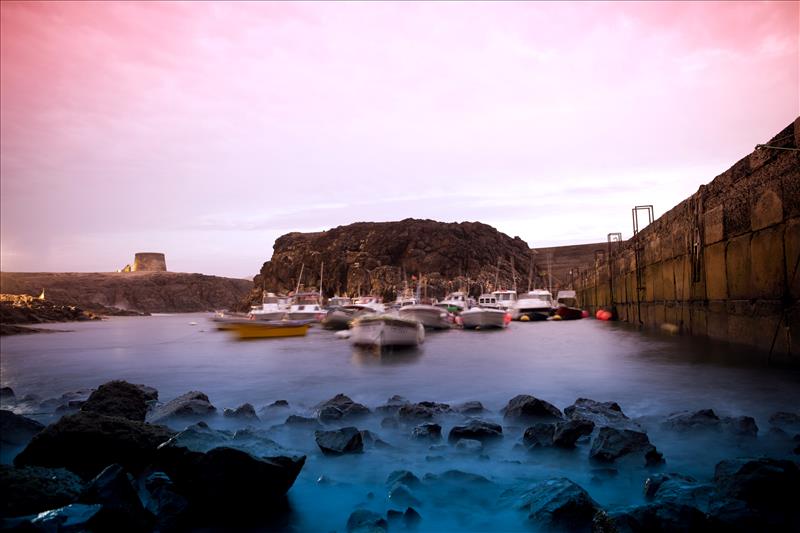
El Cotillo harbour at sunset, Fuerteventura.
El Cotillo is the old fishing village with a huge sandy beach protected by cliffs. Attractions include the laidback atmosphere, seafood restaurants and good surf! If you’re looking for the authentic this is the place to be. Make it your base or just stop awhile to enjoy lunch and admire the views, then head northwards to explore the infinity of secluded coves, laze amongst the rock pools, and finally continue around the shimmering shoreline back to Corralejo on the east coast.
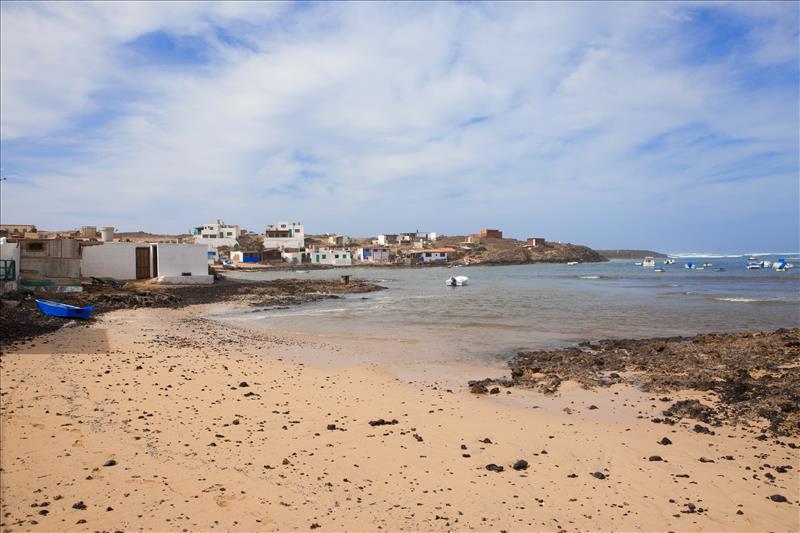
Majanicho beach on Fuerteventura north coast.
Playas Grandes and Islote De Lobos
The famous Grandes Playas lie south of Corralejo, these ten kilometres of sand dunes are the breezy ‘big beaches’ so popular with kite-boarders and windsurfers.
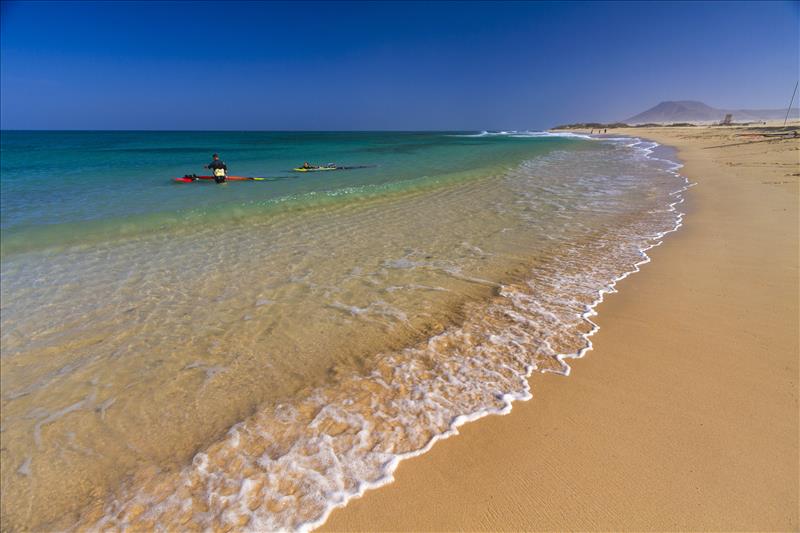
Corralejo Beach Grandes Playas, Fuerteventura.
Hop on the ferry to Isleta de Lobos a couple of kilometres offshore. A totally unspoiled islet with good dive sites, there is a small fishing harbor with a natural sea pool and further around the lovely La Concha beach, a shell shaped bay. This is the most perfect place for swimming and snorkeling so bring your towel, sunscreen and a picnic to make a day of it.
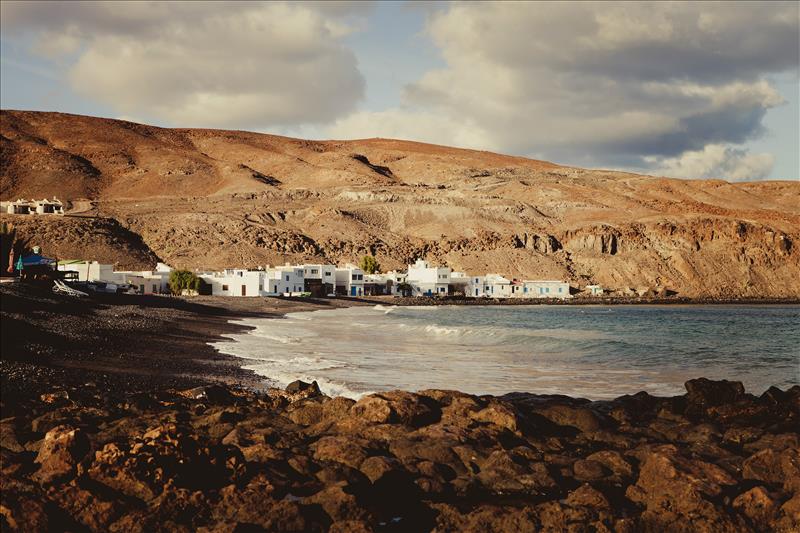
Lobos Isle, Fuerteventura.
Although Fuerteventura seems quite remote, it’s practically next door to Lanzarote. If a conventional holiday appeals more, stay on this neighbouring island and come over on a day trip ‘buggy safari’ for a taste of adventure.
Fuerteventura has an exotic pulse, sultry wild beaches blown by the winds, low lying volcanoes baked by the sun, a timeless land, an experience never forgotten.
Advice on How to Get to Fuerteventura
By Air
Direct daily flights to Fuerteventura Airport from Tenerife and Gran Canaria.
There are direct flights to Fuerteventura from various cities in mainland Spain and several European countries.
By Sea
Daily ferries from Gran Canaria and Lanzarote.
* Unless otherwise stated all photos are courtesy ‘Hello Canary Islands‘.
Canary Islands Information Guide
List of Canary Island National Parks
- Teide National Park – Tenerife
- Caldera de Taburiente National Park – La Palma
- Los Órganos – La Gomera
- El Bajón – El Hierro
- Caldera de Bandama – Gran Canaria
- Timanfaya National Park – Lanzarote
- Islote de Lobos – Fuerteventura
Sports and Activities in the Canary Islands
Walking in the Canaries
If you like walking, you’ll be at home in the Canaries… the unworldly Canary Island trails traverse all the islands ranging from pleasant treks to strenuous hikes through a varying landscape of Sahara like dunes, barren volcanic rocks or verdant rain forest vegetation.
Cycling in the Canaries
Get on your bike to discover the 7 Canary Islands – whether it’s cycling gently along the flatter coastal zones and cross country routes or riding through the mountainous terrains, you’ll love the feeling of freedom that two wheels always bring.
Watersports in the Canaries
A paradise for watersports of all kinds, the best islands for surfing, windsurfing, kitesurfing and bodyboarding are Gran Canaria, Tenerife, Fuerteventura and Lanzarote.
Diving and Snorkelling in the Canaries
There are amazing diving sites on all 7 islands and Mar de las Calmas marine reserve off El Hierro is considered one of the best in Europe. Not an expert? Well, the Canary Isles are the perfect place to learn scuba diving, or for some beautifully laidback underwater fun simply snorkelling.
Sailing and Kayak in the Canaries
Whether it’s seriously sailing the seas, just mucking about in boats or ferry hopping the isles on a budget, you’ll love to know there are at least 30 ports and marinas along the Canary Island coastlines. There’s something for everyone’s taste and pocket from skippering luxury yachts to cooling kayaking sheltered waters.
Paragliding in the Canaries
You’ve walked the trails and sailed the seas so now it’s time to get a bird’s eye view of that unique Canarian landscape from the skies. The constant Trade Winds blow across cliffs and mountainside creating the perfect take-off points on all 7 Canary Isles.
Golf in the Canaries
Is golf your dream? Well, you can actually play golf in the Canary Islands all year round due to the clement weather! The top notch courses on Tenerife and Gran Canaria are probably the most famous but it’s worth checking out Lanzarote, Fuerteventura or even La Gomera too.
Whale and Dolphin spotting in the Canaries
The Atlantic is brimming with marine life just off the Canary coasts. Dolphins and whales are fascinating sea creatures to watch in their natural habitat so take advantage of your time in the isles and enjoy a boat trip out to their favourite playgrounds. Over 24 species of migrating cetaceans can be seen in these deep, clear waters -bottlenose or spotted dolphins, sperm whales, pilot whales, finbacks and even the rare blues, amongst others.
Popular whale and dolphin excursions leave from the following harbours:
- El Hierro: La Restinga to visit El Bajón marine reserve.
- Fuerteventura: Corralejo and Morro Jable for east coast trips.
- Tenerife: Los Cristianosand Los Gigantes on the southwest coast.
- La Gomera: Puerto Vueltas (Valle Gran Rey) sea excursions.
- La Palma: Tazacorte for west coast expeditions.
- Lanzarote: Puerto Del Carmen, Puerto Calero Marina & Playa Blanca.
- Gran Canaria: Puerto Rico (Mogán) east coast sea safaris.
Starlight Reserves and Stargazing in the Canary Islands
Dark Skies tourism is a travel trend and the Canary Islands are top contenders with a plethora of top Astronomical Heritage Sites. If you love observing the constellations, visit La Palma, Tenerife or Fuerteventura as these islands are exceptional Starlight Reserves which means they have some of the purest Dark Sky environs in the world!
In fact, all 7 Canary Isles are awe-inspiring destinations for stargazing in the Northern Hemisphere.
You can contemplate the Galaxy from the heart of La Gomera, see the stars trail across the Milky Way from the volcano fields of Lanzarote, camp out under a canopy of stars in Gran Canaria (the ultimate DIY glamping experience), or go out to El Hierro’s western cape as the setting sun departs Europe on an eternal adventure across the Atlantic leaving behind infinite star-studded heavens.
Here are some of the best locations to observe the night sky in the Canary Islands:
- La Palma: Roque de los Muchachos Observatory; Llano del Jable natural viewpoint, El Paso.
- Tenerife: Teide Observatory; Guajara Mountain natural observatory, Teide National Park.
- Fuerteventura: Tefía Astronomical Observatory; La Atalayita observation point, Pozo Negro.
- Gran Canaria: Roque Saucillo Astronomic Observatory;Llanos de Garañon campsites, Tejeda.
- Lanzarote: Peñas del Chache observation point, north of Haría.
- El Hierro: Orchilla Lighthouse natural observatory.
- La Gomera: Summit of Garajonay natural observatory.
Useful advice for travelling to the Canary Islands
Local Time
The Canary Islands are on the Prime Meridian Line which means local time is GMT+1, the same time zone as the UK but one hour less than mainland Spain.
Money Matters
Currency: Euros
Banks and ATMs available on all of the inhabited Canary Islands including La Graciosa.
Visa Information
Members of the EU Schengen Area can enter the Canary Islands with a valid National ID Card; citizens of the UK, Norway, Iceland, Switzerland and Liechtenstein must travel with a valid passport; other nationalities should check current visa requirements on their Foreign Office websites.
Weather in the Canary Islands
The Canary Islands have the ideal climate for a holiday with sunshine all year round which is moderated by the Gulf Stream and Trade Winds. It’s warm and sunny, not sweltering hot, with mild pleasant nights.
In the summer months there is virtually no rainfall and in winter the probability of a downfall is only 3 or 4 times a month!
June to October temperatures range from a high of 27-28ºC and low of 19-21ºC, while November to May brings averages of maximum 20-23º and minimum 15-17ºC. Yes, beach and pool weather all year round!
However, a subtropical effect and their unique topography mean that each island has its own microclimates and temperatures can fluctuate especially at night in the mountains.
- Lanzarote is the glorious sunshine isle. Only 100 km from Africa’s coast, the weather here is hot and sunny all year, with little or no rain at all. Don’t forget to use high factor sunscreen as the sea breeze can be deceptively cooling.
- Fuerteventura weather is amazingly hot and dry throughout the island, at any time of year. Although it can be extremely windy along the vast open stretches of sandy beach and offshore, there are sheltered bays and inland is less breezy.
- Gran Canaria has a remarkable climate which contrasts from the hot desert sand dunes of Mas Palomas on a sunny eastern coast bathed by the sea, to the diverse contrasts of the alternating arid or humid inland mountain landscape.
- Tenerife southern resorts are fabulously sunny all year -bask on the beach in wintertime too with a snowy Mount Teide in the distance! Northern Santa Cruz is hot and dry while inland, and west coast Puerto de la Cruz, are tropically prone to showers.
- La Palma has perfect weather for everyone, beautifully warm and sunny on the coasts with a heart of lush tropical forest. However, evenings can be chilly in the mountains so wrap up if you’re overnight hiking or going out to enjoy star gazing!
- La Gomera is a realm of its own. The southern part of the island is sunniest while the north is likely to be cloudier. The forests of the highlands of Garajonay Biosphere Reserve attract moisture which creates greenness and irrigates the inland valleys.
- El Hierro weather is continually sunny around the coastal areas with a high central plateau where clouds form creating a microclimate rainforest. It’s a great place for sea diving year-round although the ocean is a little cooler in winter.
How To Get Around The Canary Islands
- Car hire and petrol are more economical in the Canary Isles than mainland Spain due to the tax-free status. This is the best way to explore the islands.
- Local buses are a cheap way of getting around although service and frequency are limited in remoter parts of the islands and you obviously can’t get everywhere.
- Excursions by coach or boat are available to visit the main tourist sites.
- All of the Canary Islands can be reached by daily ferry services including La Graciosa and Isla de Lobos.
- The 7 main Canary Islands have airports where you can get inter-island flights, these are usually more expensive than ferry crossings but generally quicker. La Gomera and El Hierro do not have direct flights to mainland Spain or other countries.
- Residents of the Canary Islands are entitled to discounts on airfare and ferry tickets.
How to get around Tenerife
Tenerife is 2.052 km² in extension.
Tenerife has a comprehensive transport system with an excellent public bus network around the island and to the major points of tourist interest. Santa Cruz city has a modern tram service which links to La Laguna. Tenerife has 2 international airports which are easy to reach by public bus.
Getting to Tenerife North Airport (TFN).
From Tenerife North Airport the distance to Puerto de la Cruz is 27 km which takes approx. 30 minutes by car. Bus line 20 will take you into the capital Santa Cruz in 20 minutes.
Express bus 343 connects Tenerife North and Tenerife South airports, a journey which takes around 50 minutes in normal traffic conditions. This route runs from Puerto de la Cruz on the northwest coast of the island down to Los Cristianos in the south.
Getting to Tenerife South Airport (TFS)
The distance to Las Américas / Los Cristianos / Costa Adeje is 20 km, roughly 20 minutes by car.
See the Tenerife local bus company website for all the routes and fares on TITSA.
How to get around Gran Canaria
Gran Canaria is 1,560 km2 in extension.
Gran Canaria has a good public bus transport system with more than a 100 routes accessing most parts of the Island. Car hire is always convenient but not strictly necessary on this island unless you want to discover places inland off the beaten track.
Getting to Gran Canaria Airport
Gran Canaria Airport is 26 km from Las Palmas city, some 20 minutes by car; Playa del Inglés is 32 km south of the airport which takes about 30 minutes.Bus line 1 runs from Las Palmas to Puerto de Mogán via the airport, stopping at Playa del Inglés and more resorts along the east coast along the way.
See Gran Canaria intercity bus website for routes and information see GuaGuas Global.
How to get around La Gomera
La Gomera is 378 km² in extension.
One of the smallest Canary Isles, the landscape is quite abrupt which should be taken into consideration when travelling by road as distances take longer than expected. Public buses run from north to south but the service is more limited that the ones on larger islands.
Car hire is no doubt more convenient. Organised day trips from Tenerife are a popular way of seeing the island if time is limited.
Arriving by Ferry in La Gomera
Daily ferries from Tenerife and El Hierro, stop in San Sebastián port so this is where you’ll land if you are coming by sea.
Arriving by Air – Getting to La Gomera Airport (GMZ).
La Gomera Airport is located 5 km from Playa Santiago and only 5 minutes away; San Sebastián de La Gomera is 35 km from the airport, some 50 minutes in car. Bus line 7 links the airport to both resorts.
The distance from La Gomera Airport to Valle Gran Rey is 45 km, that’s an hour by car. You can get there on bus line 6.
See La Gomera bus timetables and full routes on GuaGua Gomera.
How to get around El Hierro
El Hierro is 278 km² in extensión.
The Canaries smallest island, measuring only 50 km from north to south with a steep mountainous landscape, it can also be the most challenging to get around. Nine bus routes reach the local towns and villages, and a limited service makes renting a car, or motorbike, a compelling option.
Getting to El Hierro Airport (VDE)
Bus line 10 links El Hierro airport to the capital Valverde in 15 minutes. The distance from the Airport to La Restinga is 41 km, 52 minutes by car.
Details of El Hierro local transport on TRANSHIERRO.
How to get around La Palma
La Palma is 700 km² in extensión.
La Palma is the most fascinating Canary Island with a distinct eastern and western side separated by a high tree-clad volcanic ridge. There is an adequate public bus service to the main towns and villages, and a half hourly service linking the east coast to the west.
Excursions and organised walking tours are available but if you want to do your own thing and explore the island at leisure car, motorbike or even jeep, hire is a must.
Getting to La Palma Airport (SPC)
La Palma Airport is on the east coast, 9 km from the capital Santa Cruz, number 5 bus links La Palma airport to Los Cancajos only 5 minutes away, and Santa Cruz. Puerto Naos is 40 km away on the west coast, a journey that takes about an hour by car.
See La Palma bus routes and timetables on the TILP web.
How to get around Lanzarote
Lanzarote has an extension of 795 km²
The most easterly island on the Canaries, there is a decent bus network and the island is geared to tourism with coach tours readily available. Renting a car or motorbike is the ideal option if you want to explore further.
Getting to Lanzarote Airport (ACE).
Lanzarote airport is near Arrecife and Puerto del Carmen is only 10 km away, 15 minutes by car; Playa Blanca is 33 km south of Lanzarote Airport, some 30 minutes by car. Public bus lines 161 and 261 links Lanzarote airport to Puerto del Carmen and Playa Blanca.
Check all La Palma bus routes and timetables on Arrecife Bus site.
How to get around Fuerteventura
Fuerteventura has an expansion of 1,732 km²
This makes it the second biggest Island in the Canaries but it is much less populated than Tenerife or Gran Canaria. It’s a fairly flat island so is simple to drive around and great for cyclists.
Getting to Fuerteventura Airport (FUE).
Fuerteventura Airport is on the east coast of the island near Puerto del Rosario. Get bus number 3 from Fuerteventura airport to Caleta de Fuste only 8 km away, and to Puerto de Rosario; from Puerto del Rosario bus number 6 will take you to Corralejo.
Airport to Corralejo is 39 km, 40 minutes by car; airport to Costa Calma 65 km, 60 minutes by car.
Find all Fuerteventura bus routes, timetables and fares on the local transport website TIADHE.
Flights between the Canary Islands
| INTER-ISLAND FLIGHTS | TRAVEL TIME |
| Gran Canaria – El Hierro | 55 minutes |
| Gran Canaria – Fuerteventura | 45 minutes |
| Gran Canaria – La Gomera | 1 hour |
| Gran Canaria – La Palma | 50 minutes |
| Gran Canaria – Lanzarote | 40 minutes |
| Gran Canaria – Tenerife | 30 minutes |
| Tenerife – El Hierro | 40 minutes |
| Tenerife – Fuerteventura | 50 minutes |
| Tenerife – La Gomera | 30 minutes |
| Tenerife – La Palma | 30 minutes |
| Tenerife – Lanzarote | 50 minutes |
Inter-islands flights between the Canary Islands are operated by Binter and CanaryFly.
Flights to the Canary Islands from mainland Spain
| MAINLAND SPAIN | DIRECT FLIGHTS TO THE CANARY ISLANDS | APPROX. FLIGHT TIME |
| Alicante | Tenerife | 3 hours |
| Barcelona | *Gran Canaria *Tenerife *La Palma *Fuerteventura *Lanzarote | 3 hr 15m |
| Bilbao | *Gran Canaria *Tenerife *Fuerteventura *Lanzarote | 3 hours |
| Madrid | *Gran Canaria *Tenerife *La Palma *Fuerteventura *Lanzarote | 2 hr 50m |
| Málaga | *Gran Canaria *Tenerife *Fuerteventura *Lanzarote | 2 hours |
| Santiago De Compostela | *Gran Canaria *Tenerife *Fuerteventura *Lanzarote | 2 hr 45m |
| Seville | *Gran Canaria *Tenerife *Lanzarote | 2 hr 45m |
| Valencia | *Gran Canaria *Tenerife *Lanzarote | 2 hr 45m |
Table of direct flights from mainland Spain to the Canary Islands.
More info & security regulations on the Spanish Airport Authorities AENA site.
Airlines from most European countries and North Africa fly directly to the Canary Islands. International travellers will need a connecting flight.
Ferry Routes between the Canary Islands
| ORIGIN | DESTINATION | SAILING | Company |
| Tenerife Sta Cruz | Gran Canaria Agaete | 80 minutes | Fred Olsen |
| Tenerife Sta Cruz | Gran Canaria Las Palmas | 150 minutes | Armas |
| Tenerife Sta Cruz | La Palma Sta Cruz | 175 minutes | Armas Fred Olsen |
| Tenerife Los Cristianos | La Gomera San Sebastian | 50 minutes | Armas Fred Olsen |
| Tenerife Los Cristianos | El Hierro Valverde | 165 minutes | Armas |
| La Gomera | El Hierro | 70 minutes | Armas |
| Gran Canaria Las Palmas | Fuerteventura Morro Jable | 120 minutes | Armas Fred Olsen |
| Gran Canaria Las Palmas | Fuerteventura Pto Rosario | 390 minutes | Armas |
| Gran Canaria Las Palmas | Lanzarote Arrecife | 360 minutes | Armas |
| Lanzarote Playa Blanca | Fuerteventura Corralejo | 25 minutes | Armas Fred Olsen |
Table of ferry connections between the Canary Islands.
The main ferry lines operating between the different Canary Islands are with Naviera Armas and Fred Olsen.
Which is your favourite Canary Island? Can you guess mine?
Travel Guides to Destinations in Spain
Travel Guide to the Costa Blanca
The Costa Blanca is a famous stretch of coast in southeastern Spain, where a warm Mediterranean Sea bathes an infinite diversity of white sand beaches and pebble bays encircled by distant mountain peaks. Follow me on a journey down the coastline, an insider’s Alicante travel guide to the Costa Blanca in Spain.
Granada: What to See in 3 Days
Our 3 day city guide to Granada, one of the most beautiful cities in Spain – the world famous Alhambra Palace looks down onto a maze of chic plazas and historical monuments in the extrordinary old town centre…
Barcelona city is an open-air museum with a multitude of fascinating things to see. Follow our Barcelona 2 day itinerary through the historic quarter down to the fashionable seafront boulevard.
There are so many things to do in Málaga (Spain), lots of history, great food and beaches. Explore Málaga – sun, sea and history on Spain’s Costa del Sol.
Sailing around Mallorca and the Balearic Islands
Sailing around Mallorca and the Balearic Islands you’ll discover a Mediterranean seascape of turquoise waters framed by pine-clad coves and sandy bays.
Whether you’re boating, relaxing or partying, you’ll find lots to do on Spain’s favourite holiday islands.
Discover the World with![]() the blog with a focus on independent travel
the blog with a focus on independent travel




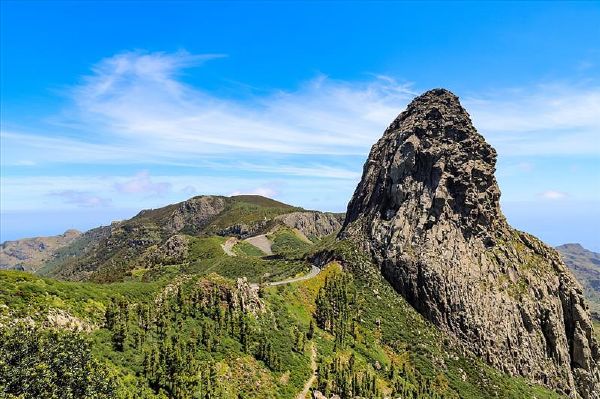
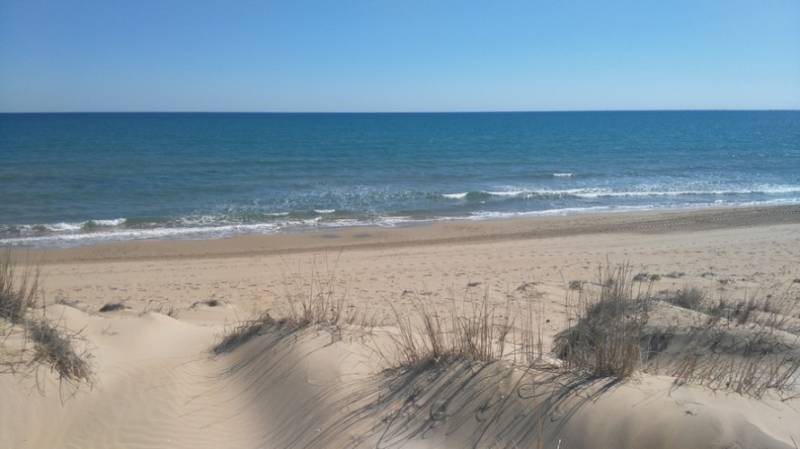
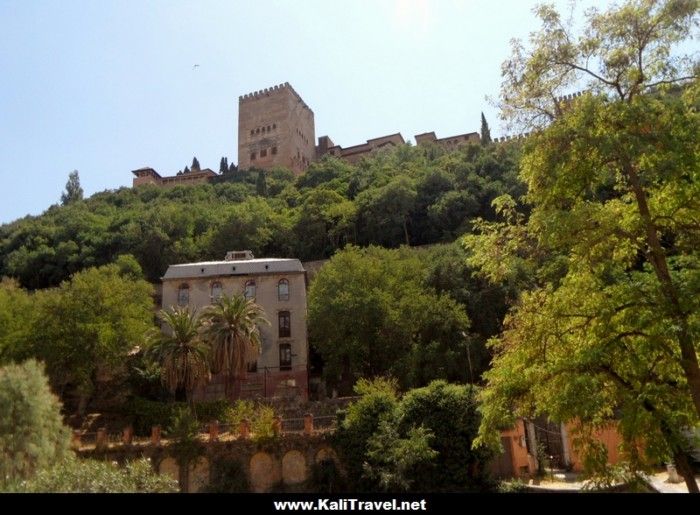
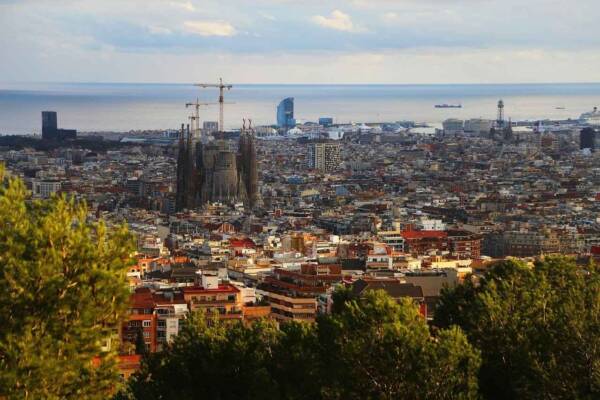
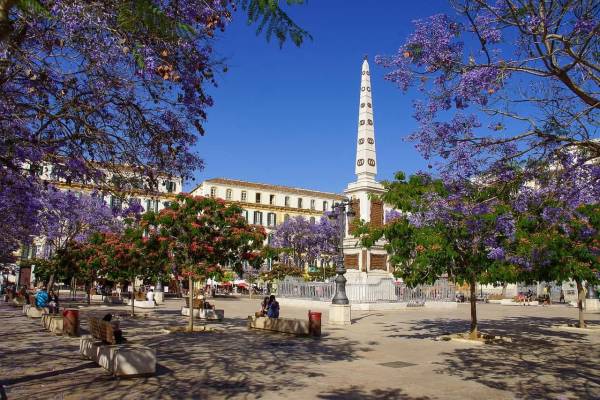
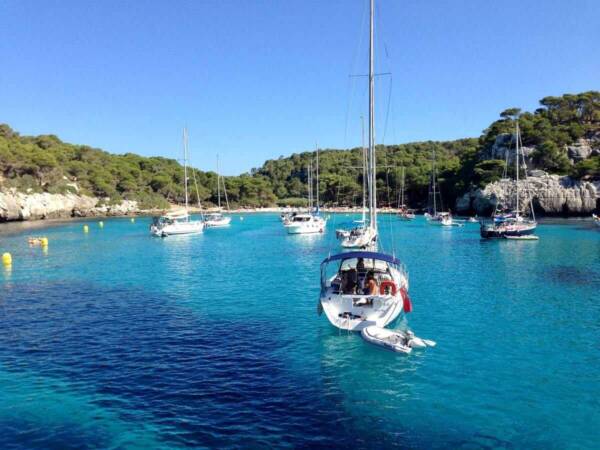
What an amazing guide! I wanted to visit the Canary Islands pre-covid. and your guide + photos just make me want to visit more! very practical and detailed guide. thanks for sharing!
Very comprehensive article, Kali, love it.
Only been to Fuerteventura, but now thinking I must visit Tenerife and Gomera too.
Garajonay National Park seems right up my alley. Would love to go hiking there for a week.
Also, I had no idea but found the mythology super-fascinating.
Wow! What an amazing and the ultimate guide to visiting the Canary Islands! I’ve always wanted to visit as I’m sure I’d love the beaches, hiking scuba diving off of El Hierro. Thank you for so much great info!
Wow such diverse landscapes with all the islands! A great guide and introduction to all of them!
OK, I can’t take it anymore… I need the sea!!!!! What a beautiful post and fantastic images! I’ve never been to Canary but it’s on our list and this is a side I haven’t seen! Thanks so much for the wonderful share.
Great information! That seaside pool looks amazing. I could definitely see myself spending a lot of time there.
A really thorough, informative and well structured guide. Great for anyone visiting this area! Will definitely keep to hand for future reference.
You asked me to be honest so I will be. I never considered the Canary Islands before, it always seemed perfect for the beach goers. That’s not me. So now the honest part. Your guide has made me reconsider. The hiking, the unusual landscapes seem perfect for me. El Hierro in particular looks amazing. Truly great guide, what else can you ask for in one.
I’ve only been to Lanzarote and I absolutely love the island. I hope to explore the rest of the islands and maybe retire somewhere over there at some point! Great guide!
Anda
This is a first-class, detailed, and choke for of information guide. Wow! You can tell you put a lot of time and work into this. BRAVO! We will save this great info when we plan a trip there. Thanks so much! Cheers!
You had us at Atlantis… What a phenomenal guide for Canary Islands! The land of legends, beaches, history… and food!!! We must, absolutely must plan a long vacation there exploring each of the islands!
Fantastic! The most comprehensive guide on Canary Islands, with all details and professional photos.
Honestly your article encouraged me to visit the islands!
I appreciate you for accuracy of the information and spending long time. you were the best as usual.
What a brilliantly comprehensive post, thanks for pulling it all together! The landscapes in the Canary Islands are truly stunning, this is definitely making us want to head there soon. Would love to do some hiking around Tenerife!
The rock pools look amazing! I’ve heard so much about these beautiful islands but never really read much about them. Your post was super and very extensive.
Absolutely amazing guide, everything you need to know. Beautiful places, i haven’t been to nay but ypu definitely pursuaded me now!
Chris – cjattractionsguide.wordpress.com
I know Spain got hit hard with corona, glad things are gradually reopening! Looks gorgeous
This is so useful. I hope to get their someday on my boat so am bookmarking for later use!
This looks like an absolute paradise! I would love the seaside pool and all the hiking. Incredible guide!
Amazing info! Thanks for taking the time to help us all with our travel planning!
Thank you for writing such a well-researched article on this destination. I would love to visit the Canary Islands one day.
Wow, this is such a detailed guide to all the Canary Islands. I’ve visited Tenerife and Lanzarote, and I’d love to visit the other islands. I love the warm weather and great scenery and beaches. I’ll definitely start planning my next trip after reading this post!
Wow – your pictures make this place look like a true paradise! I feel like the Spanish Canary Islands are a hidden gem and aren’t often visited by Americans – this has definitely inspired me to plan a trip asap!
Fuerteventura has been a bucket list destination for a while, but maybe I should add in some of the other Canary Islands!
Lovely post and the photos are fantastic. I feel like visiting this piece of heaven right away.
Amazing guide! So much information. Thanks for sharing all this. I saved this for next time